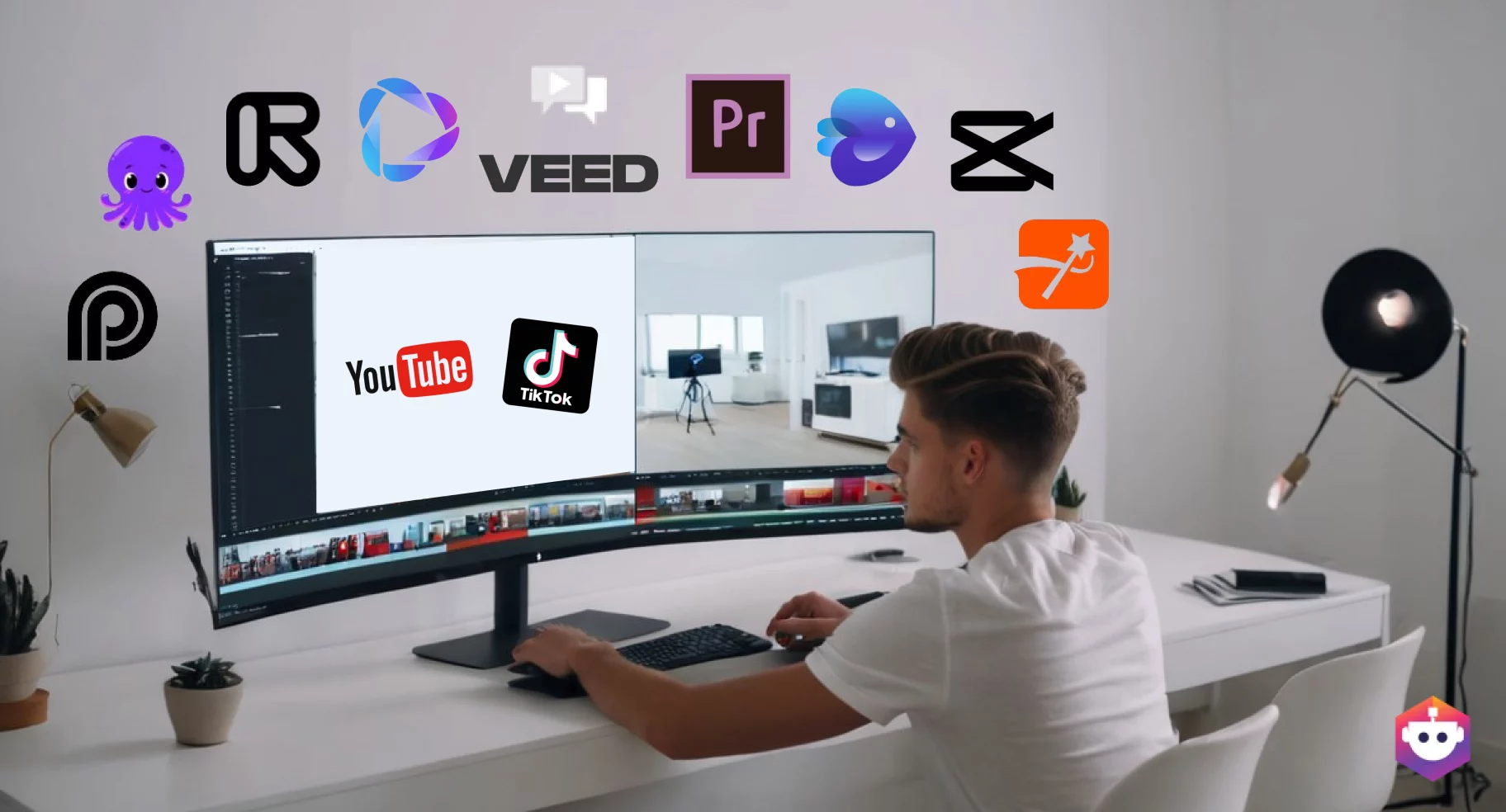
Lately, video content has established as the primary source of information on the internet. People prefer to watch a video instead of reading a long article. And, this is understandable. Watching videos is way easier than reading online. This creates an ennourmous opportunity for everyone who wants to get more exposure for their personal brand or business.
Now, with the advancements in technology and AI, creating professional-looking videos has never been easier. Even complete beginners can high-quality video content.
In this article, you can learn about 17 must-have AI tools to help you create an automated faceless YouTube channel. They will help you generate, auto-edit, and enhance your videos quicker than ever before and become a YouTuber.
P.S. We have hands-on experience with each of these video tools and have spent time and money trying to find the most efficient and effective way to produce video content that gets views. We’ve hand-picked only the most effective and proven tools.
Let’s go!
Which are the best tools to create YouTube videos with AI?
Best video editor: Capcut
Best video editor for beginners: Veed
Best template-based video generator: Invideo
Best article to video generator: Pictory
Best long to short clips cutter: Opus
Best editor for short clips: Submagic
Best talking avatar video generator: HeyGen
Best text to video generator: Runway Gen-3
Best image to video generator: Luma Dream Machine
Best animated explainer video generator: Raw Shorts
What is a faceless channel?
A faceless YouTube channel is a type of YouTube channel where you don’t need to show your face. These channels focus on content without a personal presence and could include voice-only commentary of games, news, reviews, tutorials, or other content. There are a lot of niches that don’t require a person in the YouTube video, like motivation, sports, games, online shopping, and almost everything.
The advantage is that these channels can be automated to create YouTube videos with AI. They are a great side hustle, however, it has been shown that showing your face makes the channel more personal and trustworthy.
Faceless YouTube channel Ideas
There’s a lot of competition for YouTube and TikTok, so having an unique and original ideas is key to your success. Here are several ideas for starting a faceless YouTube channel:
- Animated explainer videos
- News videos
- Music videos
- Blog to video
- Educational lessons
- Food preparation and recipes
- Product reviews
- Sport analysis or compilations
- Tutorials and walkthroughs
- Do-it-yourself videos
- Data-visualization videos
- Storytelling
- History
- AI-generated art showcases
Original and unexplored ideas have the potential to attract a wider audience and generate more views. Successful content creators often use their passions, expertise, and unique perspectives to produce compelling videos that resonate with viewers.
Top AI Tools to Create a Faceless YouTube Channel
Building a successful faceless YouTube channel takes a lot of time, energy, and dedication. Typically, you need to use multiple tools, like ChatGPT for creating scripts, Midjourney for images, Eleven Labs for voice-overs, and a video editor to combine everything and create the final video. However, using all of these tools is complicated.
The good news is that there are video-generation tools that combine all of these things in one place. They save you time to think about increasing your subscriber count and work on monetization.
Here are the 3 best AI video tools to help you create a faceless YouTube channel:

|

|

|
|
|---|---|---|---|
| Best for | Easy video editing with AI assistance | Video creation with templates | Creating videos from web articles |
| Editor | Video & Audio | Video | Video |
| Auto captions | Custom style | Custom style | Custom style |
| Screen recording | |||
| Filters & effects | Wide range | Wide range | Limited |
| Stock media | 2M+ | 16M+ | 10M+ |
| Music & effects | |||
| AI features | – Auto cut – Eye contact tool – Image to video – Music to video – Voice generation – Voice clone – Translation – Transcription – Remove noise |
– Edit videos with prompts – Voice generation – Text to slideshow – Video script generator – Translation – Transcription |
– Blog to video – Music to video – Image to video – Create music video – Transcription – Translation |
| Talking avatars | Custom avatars | Custom avatars | |
| Text-to-video | |||
| Collaboration | |||
| Cloud storage | |||
| Export options | 4K | HD | HD |
| Pricing | – Free with watermark – $24 per month – $32 per month – $69 per month |
– Free with watermark – $25 per month – $60 per month – $600 per month |
– Free trial – $25 per month – $49 per month – $119 per month |
| Customer support | |||
| Go to Veed | Go to InVideo | Go to Pictory |
Veed
Veed offers advanced AI features such as auto cut and eye contact maintainer, making it ideal for users looking for more automated editing assistance. It also supports a wide variety of customization options including branding, transitions, and text overlays, making it versatile for various types of content creation.
Advantages
- Easy video editor
- Many video creation and editing features
- Export 4K videos
Disadvantages
- Limited amount of voice transcription
- Poor video generation abilities
- Lacks advanced video editing capabilities like Adobe Premiere Pro
Best for: Beginner video editors
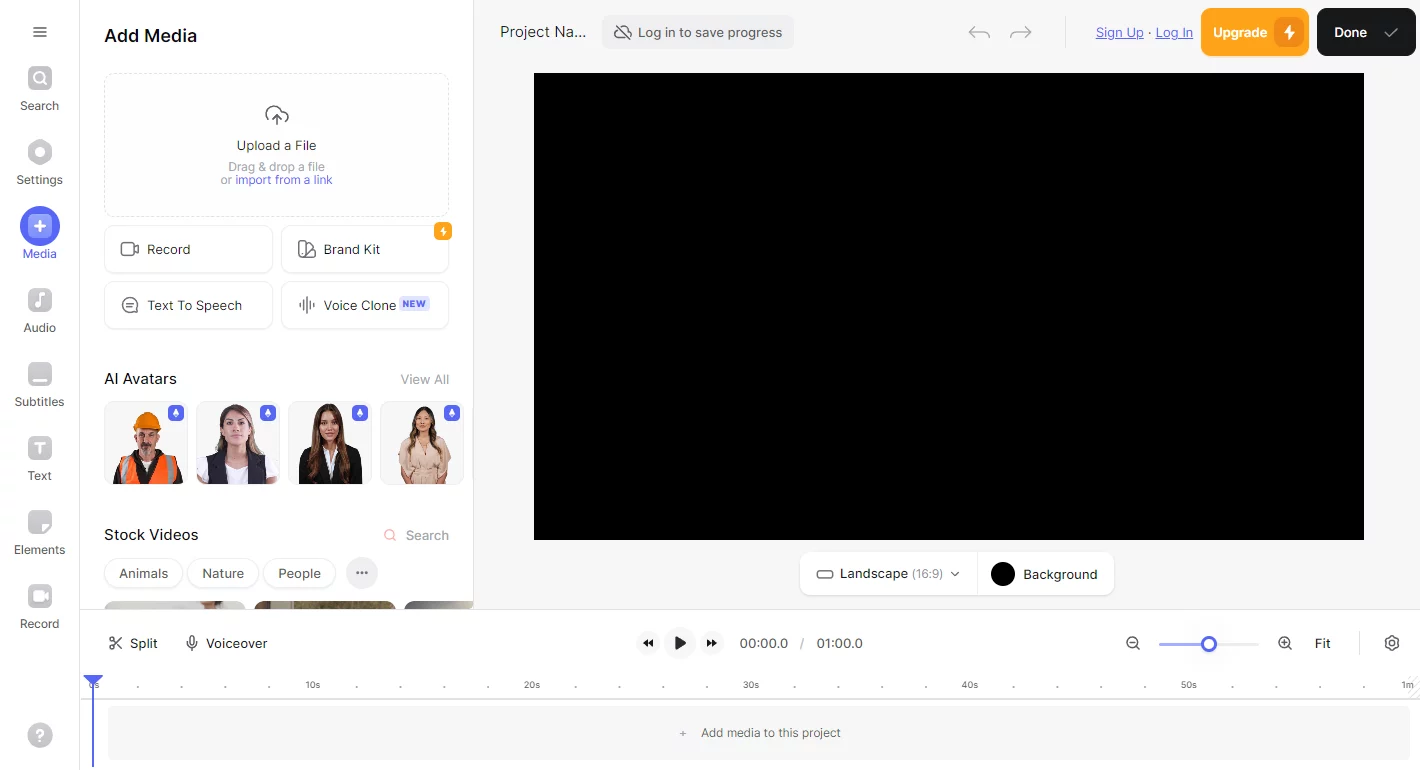
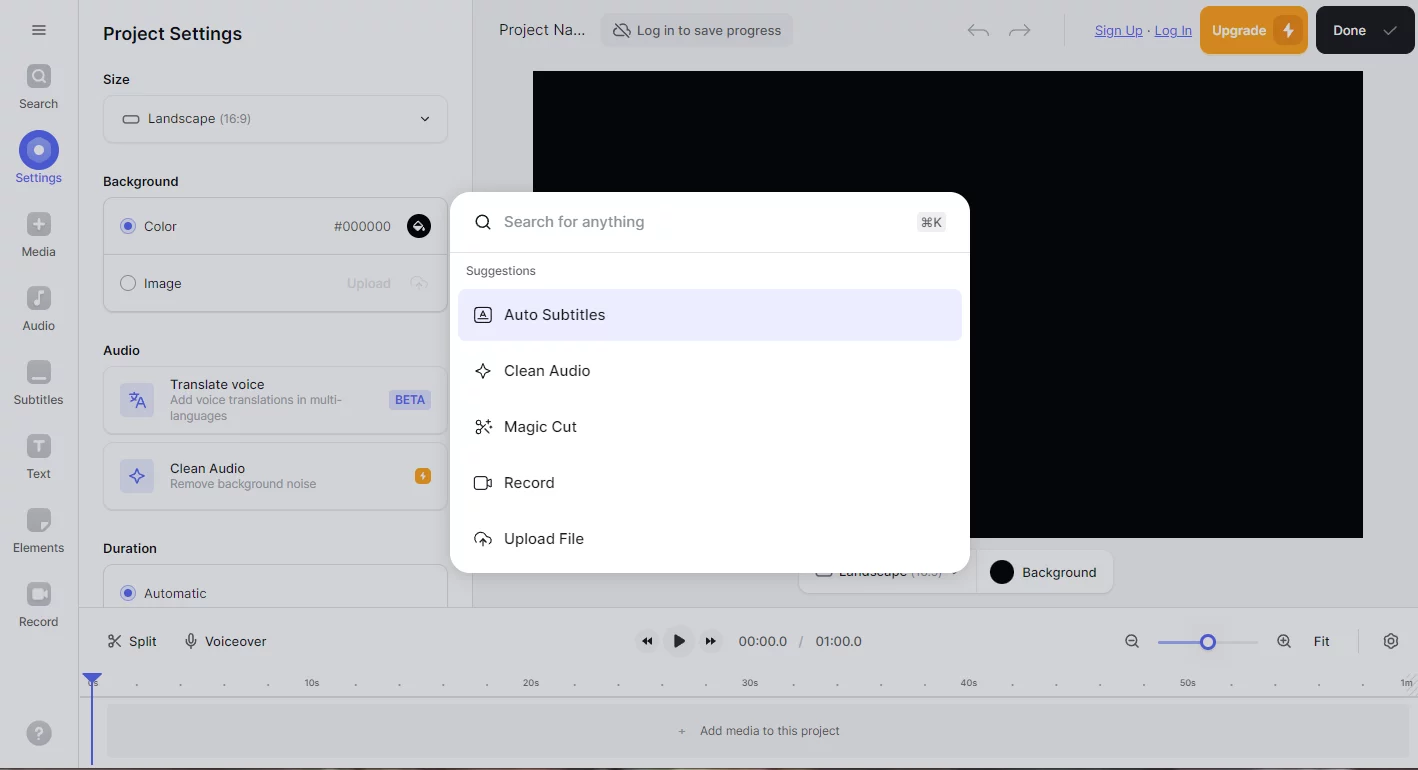
InVideo
InVideo excels in template-driven video creation, which is great for users who prefer a structured and automated approach to video making with extensive pre-made assets. It offers a comprehensive text-to-video capability and a video editor that is controlled by text prompts. InVideo is great for making faceless marketing and promotional videos.
Advantages
- Template-based video creation
- Create videos with prompts
- Easy to create videos in bulk
Disadvantages
- Expensive
- No 4K export option
Best for: Beginner video editors
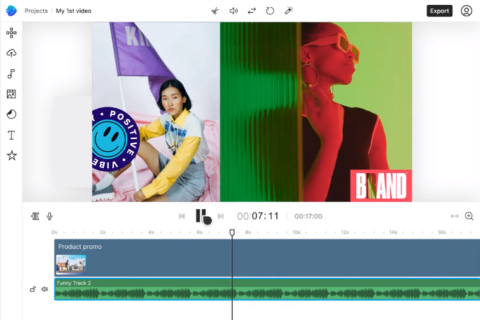
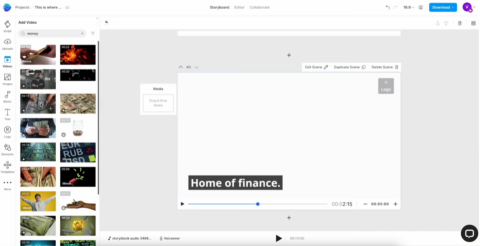
Pictory
Pictory specializes in transforming text from articles and websites into videos, which is particularly useful for content marketers and bloggers who want to repurpose written content into video format. It focuses heavily on AI-driven video summarization and transcription. It’s great for creating faceless YouTube videos from your favorite website.
Advantages
- Great at creating videos from articles
- Good customer support
- Can create a music video
Disadvantages
- Limited video and audio effects
- No 4K export option
Best for: Beginners
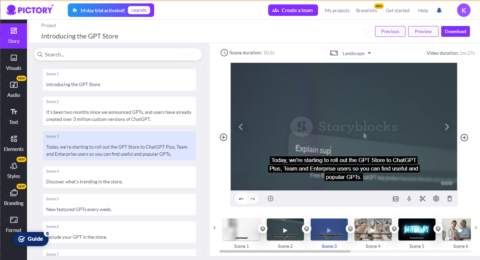
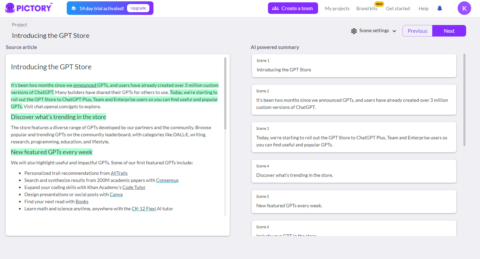
Our Recommendation
These are the top AI tools that faceless YouTubers use in 2024. They have their advantages and disadvantages. Veed makes video editing very easy and suitable for beginners. However, its text-to-video generation abilities are not good. Invideo‘s strength is creating videos by using templates, while Pictory is best for creating videos from news articles or blog post content.
Choose the video generation tool that best suits your needs. View the full list of all video generators here.
Create Short Videos
Learn how to quickly create and edit short videos 10x faster than before. This is now possible with tools like Opus, Vizard, or SubMagic. These AI shorts generators handle the entire process, including cutting video into smaller pieces, editing, removing silence, translating, adding captions, music, stock photos, and even scheduling them on YouTube or TikTok. These tools allow for significant YouTube automation.
Here are the 3 best AI Short video creators:

|

|

|
|
|---|---|---|---|
| Long to short video | |||
| Video editor | |||
| Stylyzed captions | |||
| Auto B-Rolls | |||
| Video effects | |||
| Music background | |||
| Sound effects | |||
| Post scheduler | |||
| Unique features | – Prompt to edit – Auto reframe – Export to Premiere Pro |
– Automatic editing – Auto reframe – Screen recorder |
– Title generator – Description generator – Auto-zoom |
| Templates | |||
| Collaboration | |||
| Export options | HD | 4K | 4K |
| Pricing | – Free with watermark – $9 per month – $19 per month |
– Free with watermark – $20 per month – $60 per month |
– Free with watermark – $20 per month – $50 per month |
| Translation | |||
| Go to Opus | Go to Vizard | Go to SubMagic |
OpusClip
OpusClip offers a variety of useful features, including auto cutting of longer videos into short ones, prompt-based video editing, automated post-scheduling, and export capabilities to Adobe Premiere Pro. However, it is limited to 1080p video quality and lacks advanced video and audio effects. Another advantage is its affordability, with plans starting at $9 per month, making it half the cost of Vizard and SubMagic.
Advantages
- Automatically cuts long video into clips
- Automated post scheduling
- Export to Adobe Premiere Pro
Disadvantages
- Generated clips needs further editing
- No music or sound effects
- Limited to 1080p video quality
Best for: beginners
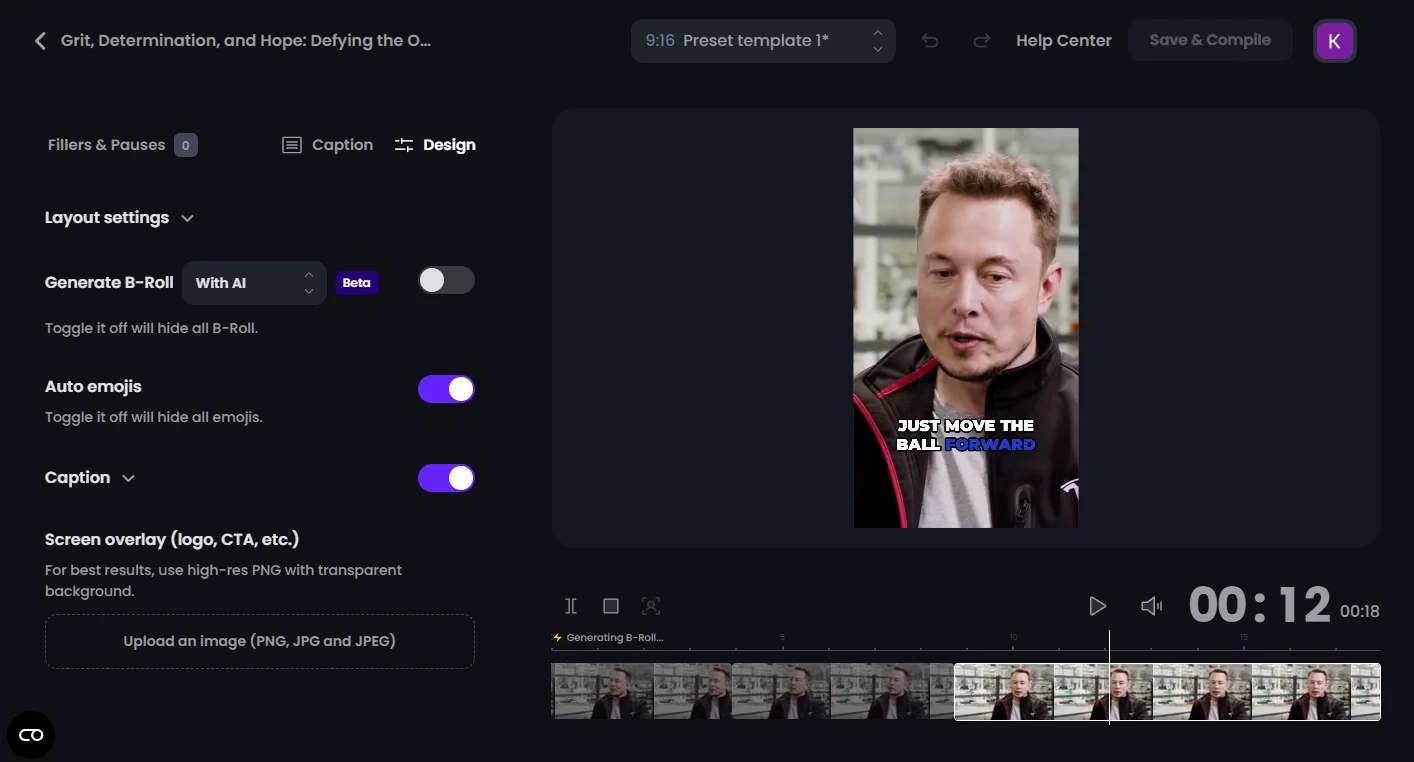
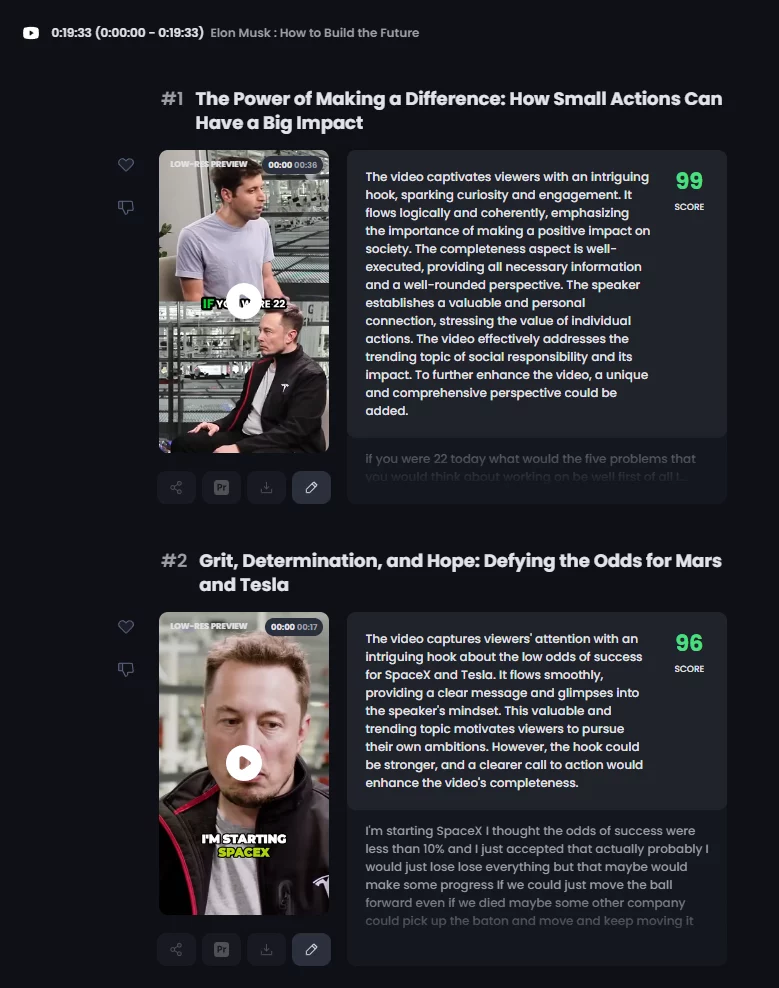
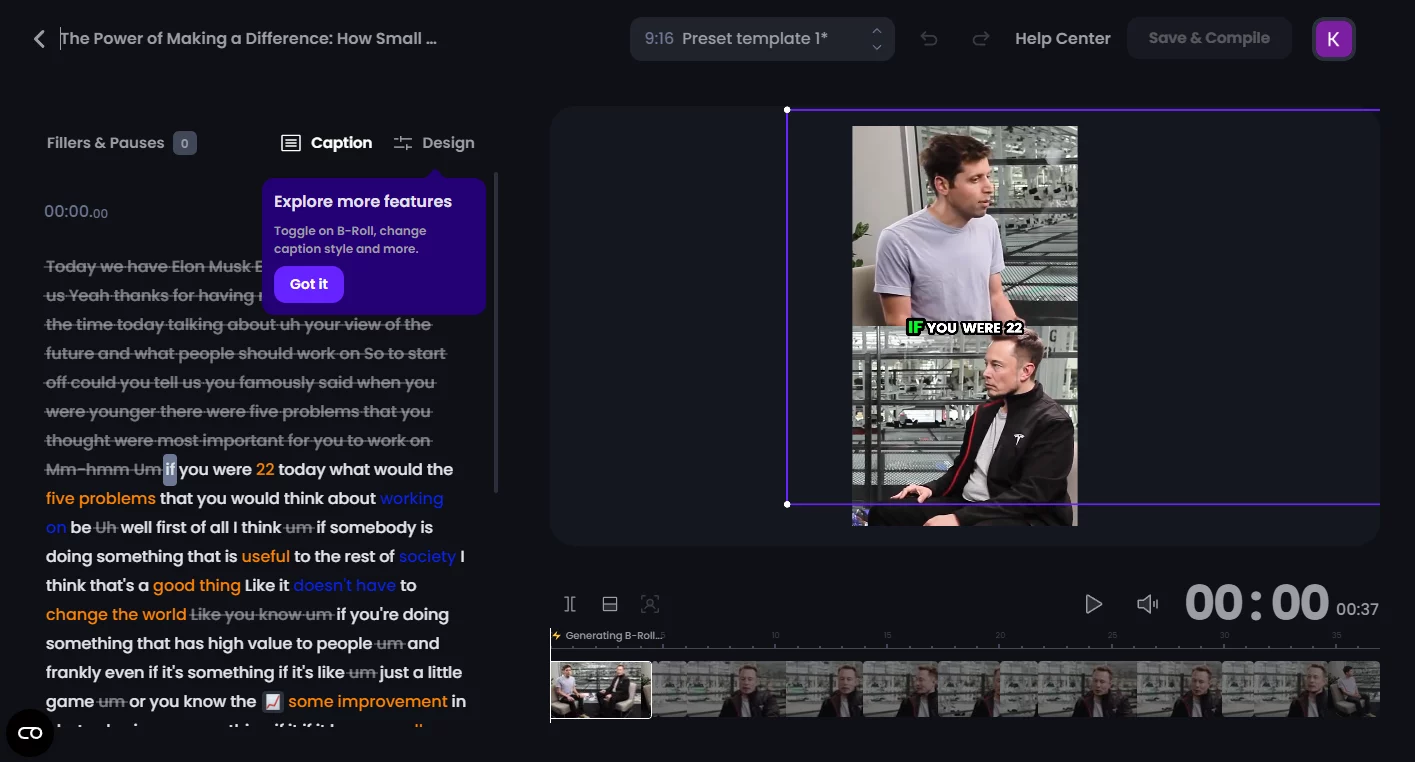
Vizard
Vizard provides similar functionality to OpusClip, with the added advantage of exporting videos up to 4K resolution. Its features include automatic editing, auto-cutting longer videos, a social media post scheduler and screen recorder. However, its pricing starts at $20 per month, making it twice as expensive as OpusClip, which may be a significant consideration for budget-conscious users.
Advantages
- Automatic video editing
- Social media post scheduler
- Export videos in 4K video quality
Disadvantages
- Can’t add audio effects and background music
- Expensive
- Limited customization
Best for: beginner podcasters and shorts video creators
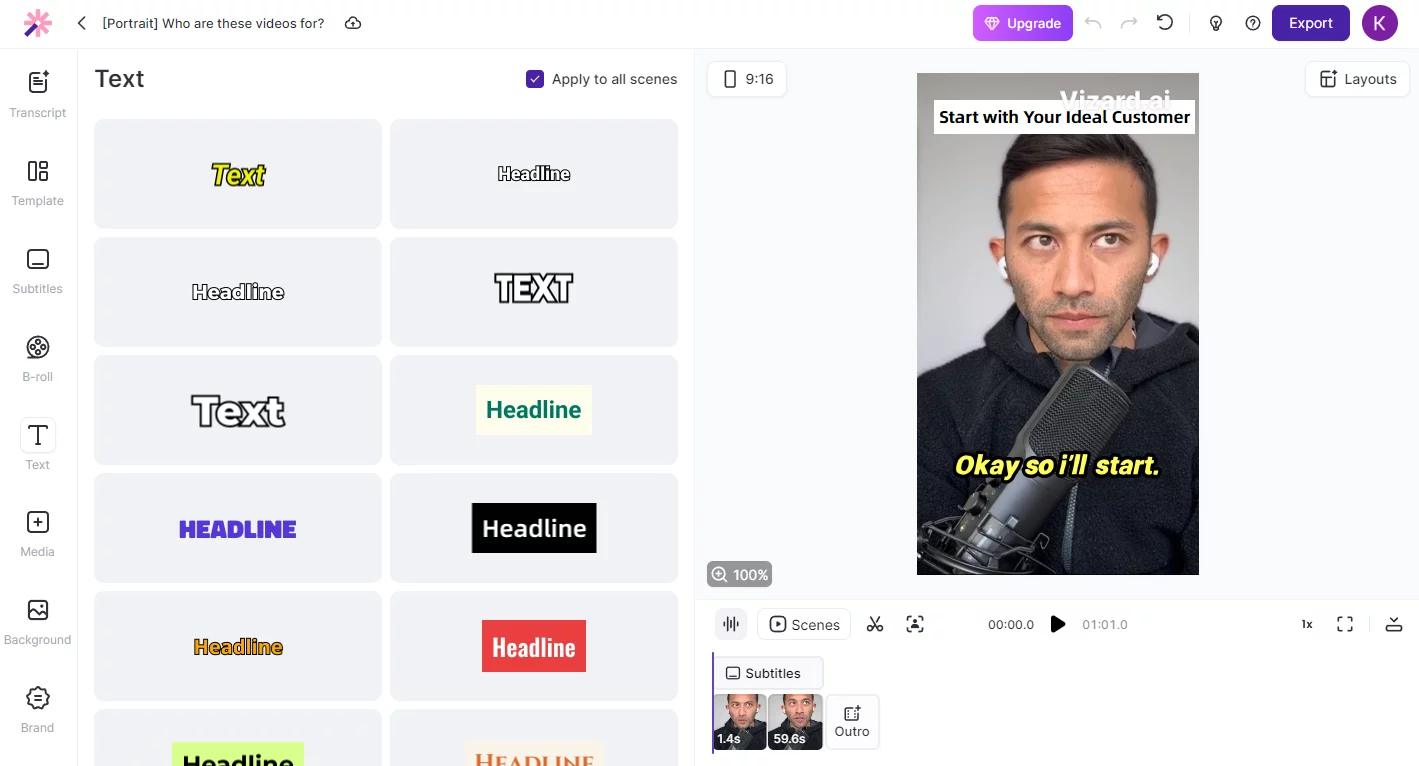
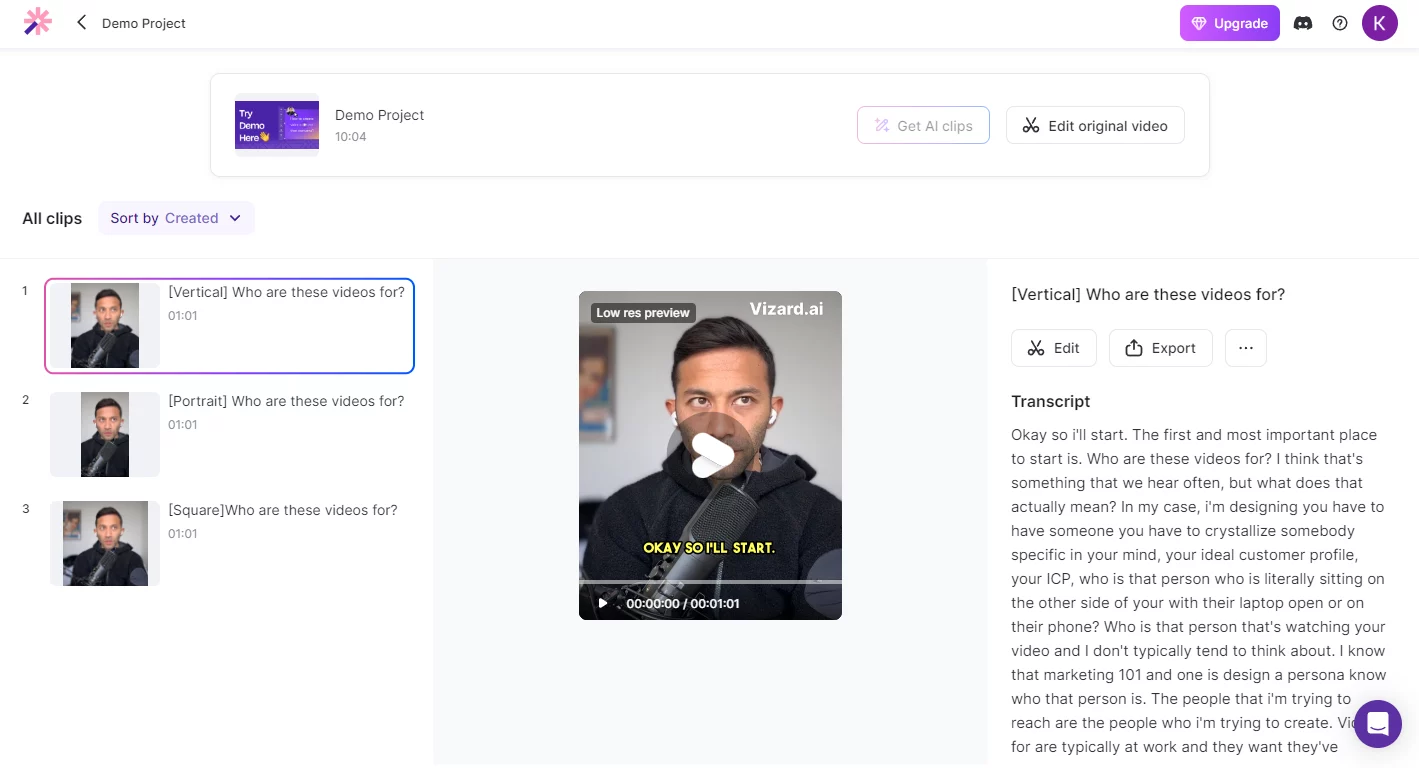
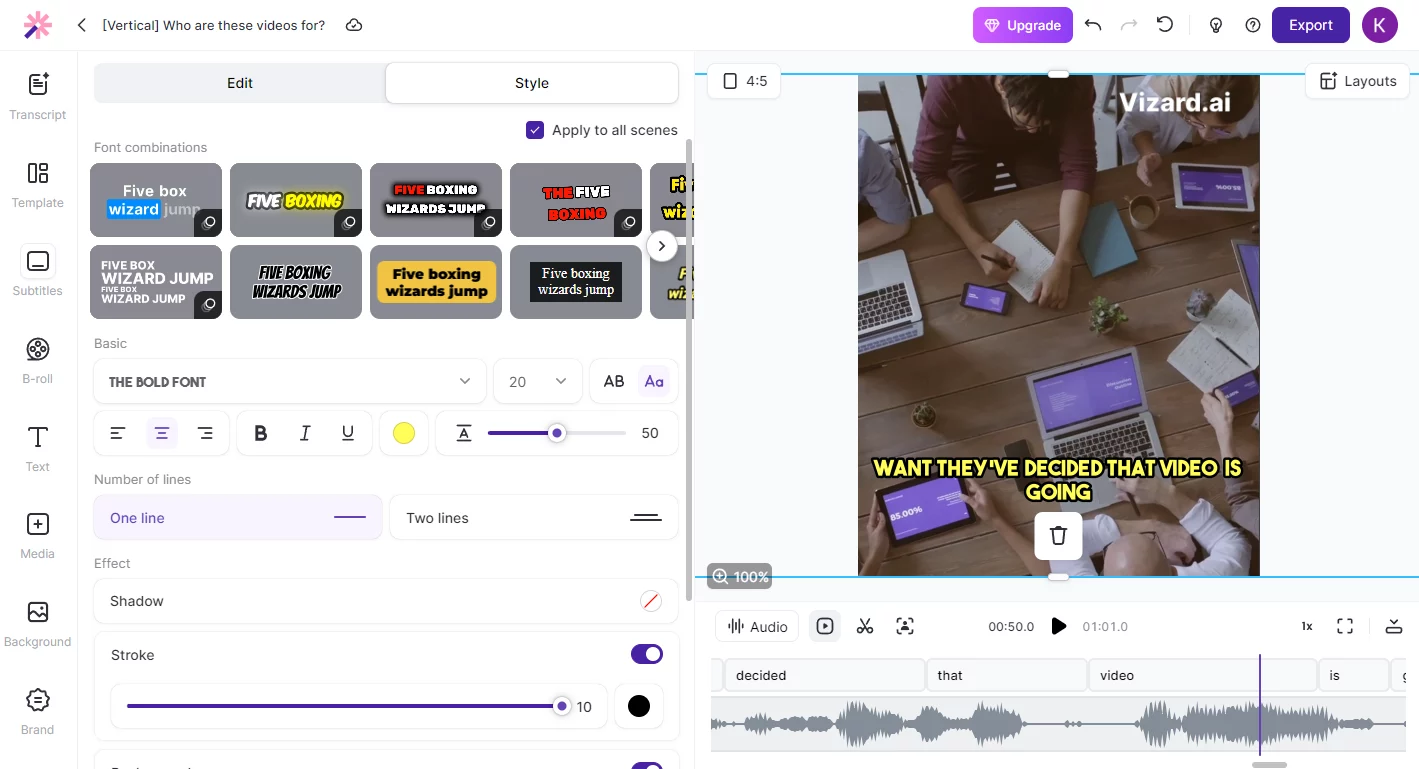
SubMagic
Submagic stands out for its ability to automatically add video effects, background music, and generate video titles and descriptions. It also supports 4K video export. However, it cannot cut a longer video into smaller ones and lacks a social media post scheduler. It’s great for putting the final touches on an already cut short video. The pricing plans start at $20 per month. However, title and description generation are only available in the $50 per month plan, and 4K video quality export is offered in the $150 per month plan.
Advantages
- Adds visually appealing captions
- Automatically adds stock photos, zooms, and sound effects
- Easy to use editor
Disadvantages
- Cannot cut longer video into smaller ones
- Lacks social media post scheduler
- Free version adds watermarks to the generated videos
Best for: beginner podcasters and shorts video creators
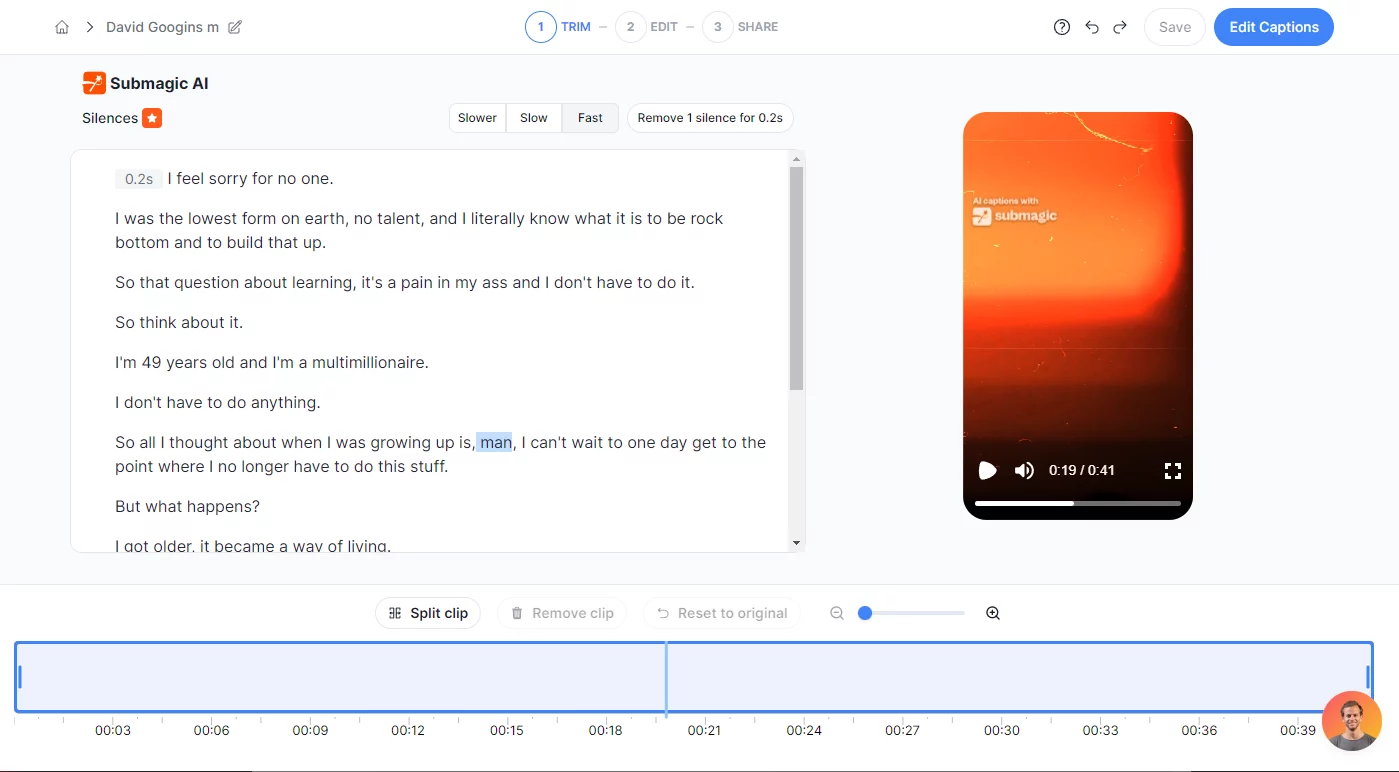
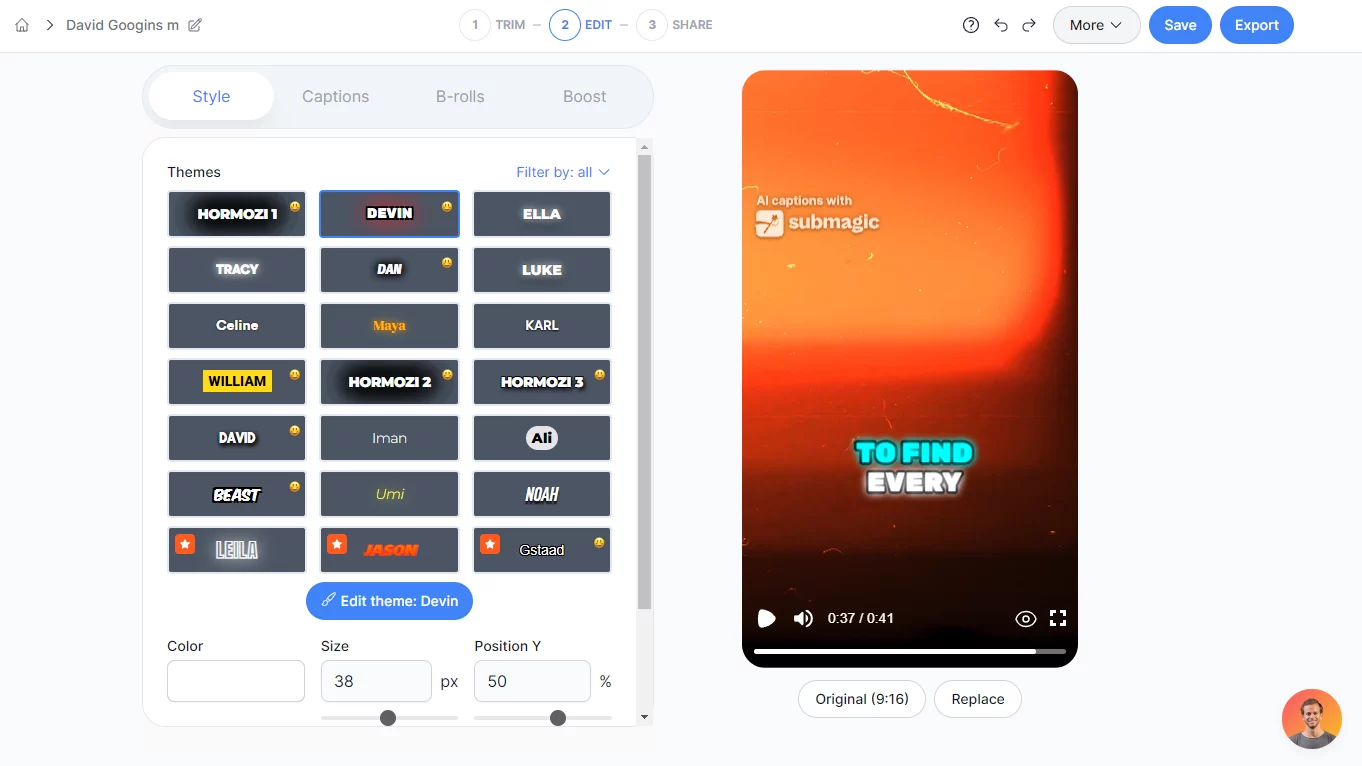
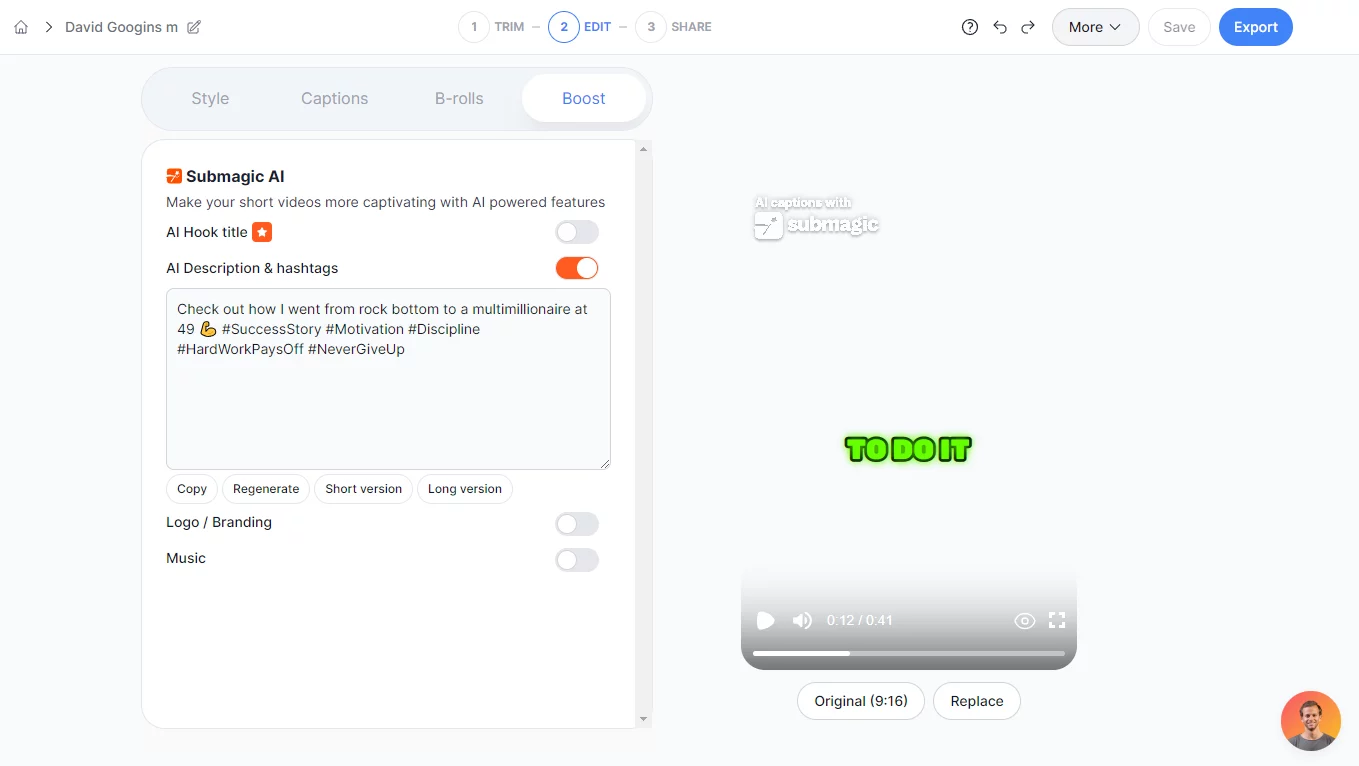
Bonus: Clips AI (Free)
ClipsAI is a free and open-source alternative to OpusClip and Vizard. It automatically cuts longer videos into shorter ones. It is completely free to use, however, it’s hard to use because it requires some coding skills to install and use. Clips AI analyzes the speech in the video and cuts it into narrative-based scenes.
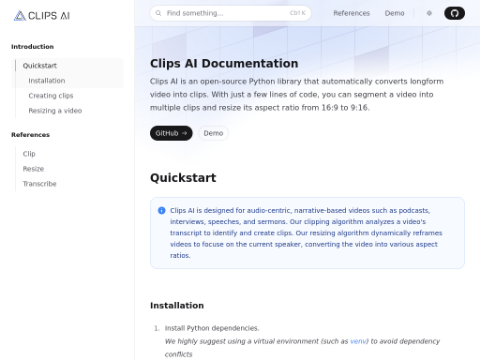
Bonus 2: CapCut (Free)
CapCut offers an automatic cutting of long videos into short clips. However, you have to download the video to a file on your computer and upload it to CapCut. It doesn’t support adding it directly from a YouTube link. However, it does support direct sharing to TikTok, YouTube, Facebook and Instagram.
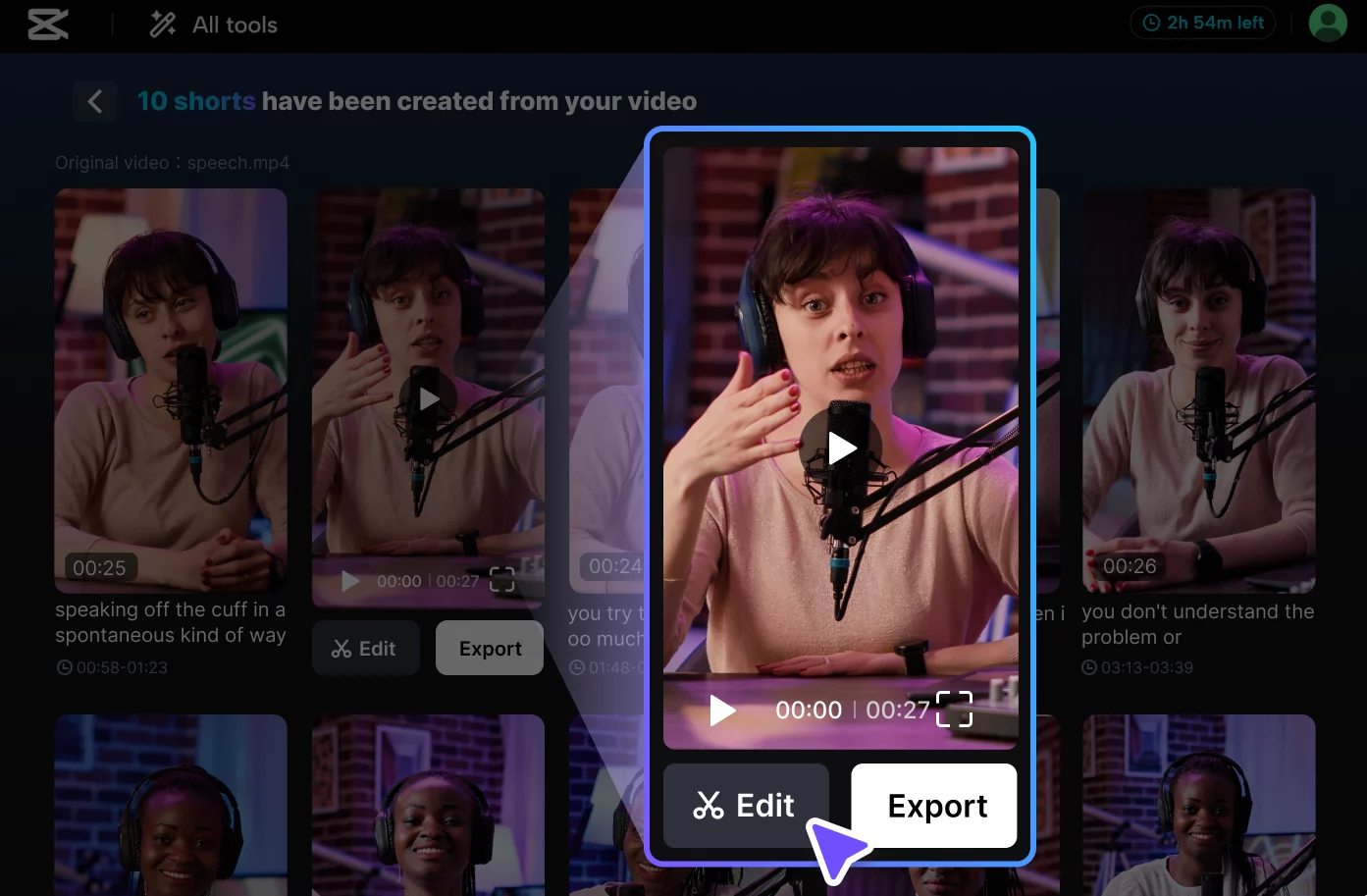
It’s a great alternative to create short clips out of a longer podcast or interview. However, the free version of CapCut allows for 1 hour of video footage to be cut down per month which is not enough if you’re serious about growing your YouTube/TikTok channel.
Our recommendation
All of these tools have their limitations. No tool can cut, edit, and auto-post a video. Currently, we need to combine two tools for cutting, editing, or post-scheduling. However, selecting the right tool depends on your priorities—whether it’s higher video quality, cost efficiency, or comprehensive editing capabilities. Evaluate your needs and choose the one that aligns best with your goals.
Our suggestion for beginners is to combine OpusClip for automated long video cutting and SubMagic for quick and final editing of the short videos.
As a free but less automated alternative, you can use CapCut to cut the video into shorts, edit them, and then publish them to YouTube or TikTok.
Evaluate your needs and choose the one that aligns best with your goals. Check the full list of short video AI tools.
Generate videos from text or an image
Generative AI video tools in 2024 have improved significantly and now can create nearly realistic videos from text prompts or images. They’ve made it possible to generate short 5-10 second video scenes that can be used for social media content, add on to your videos, or even create an AI-only movie. Unfortunately, the best ones: Meta’s Movie Gen and OpenAI Sora are not yet available for public use. Here we’ll review only the best video generation tools that you can use today:

|
|

|
|
|---|---|---|---|
| Quality | High | Medium | High |
| Clip lenght | 5 to 10 seconds | 5 to 10 seconds | 5 to 10 seconds |
| Motion accuracy | |||
| Video resolution | 1280×768 | 1360×752 | 1280×720 |
| Image to video | |||
| Text to video | |||
| Video to video | |||
| Video editing | |||
| Generation speed | 90-120s | 60-90s | 120-180s |
| Lip-sync | |||
| Sound generation | |||
| AI features | 32 | 1 | 4 |
| Ease of use | |||
| Pricing | – Free – $15 per month |
– Free – $30 per month |
– Free – $10 per month |
| Go to Runway | Go to Luma AI | Go to Kling |
Runway
Runway is an amazing video editing and generation tool that can create cinematic videos from images, text, or other video. Its latest video generation model Gen-3 creates highly realistic videos from a text description. It can also generate subtitles, remove people and things from videos, blur faces, clean audio, and more. Remember to follow these prompt tips to get the best results.
The combination of highly realistic video generation, many AI video editing features and affordable price makes it a great asset for creating video using AI.
Advantages
- High-quality video generation
- Comprehensive video editor
- Many AI features
Disadvantages
- Paid plans only offer highest quality video generation
Luma Dream Machine
The Luma Dream machine allows you to generate 5 to 10-second videos from a text prompt or an image.
Its image-to-video capabilities seem to be more powerful than the text-to-video ones. It’s perfect for animating memes, gifs, and generated images. Generating custom videos can be a great addition to your faceless videos.
Advantages
- Great image to video quality
- Supports text and image to video
- Easy to use
Disadvantages
- No sound generation
- Text output is of low quality
- High price
Kling
Kling is another AI video generation platform that allows you to generate videos from text or images. It generates 5 to 10 second videos that can be extended with up to 3 minutes. Kling provides various features such as changing camera angle, camera controls, creativity control and selecting aspect ratio.
The image to video generation tool is impressive. It supports adding an end image, so that the video can start with one image and end with another. A prompt can be added to have great control of the generated video.
However, the free version creates lower resolution videos and you need to get a $10 subscrition to get better quality videos. In addition, the image-to-video tool takes more than 5 minutes to geerate the video.
Advantages
- High quality video generation
- Can create video from two images and text
- Can create up to 3 minute videos
Disadvantages
- Slow image-to-video generation
- No video editing tools
- No audio generation
Honorable mention: Pika – high-quality video generation tool supporting a lot of visual effects, like explode, melt, crush or inflate. However, it has less features and the video quality is slightly lower than Runway, Luma and Kling.
Our suggestion
We suggest the Runway Gen-3 because it generates the highest quality videos, has a great video editor with many AI features, is reasonably priced, and it’s easy to use. However, Luma Dream Machine is superior in animating images or memes. However, Luma doesn’t have any video editing features and can only extend the generated video clip. Kling is the most affordable option starting from $10 per month. It offers great video generation quality, however it lacks editing features, lyp-syncing and other. All 3 tools are great and will create high-quality videos. Choose the one that suits your needs.
Generate News or Explainer Videos
In the past, if you wanted to go in the news or explainer video niches, you would need a studio, a presenter, and professional equipment… not anymore. Now, you can do it just by copy and pasting the script from a news publication to an AI tool. These AI tools are called AI avatars or talking avatars and they can even clone your face, voice, and gestures. Here we’ll compare the top 3 best AI avatar tools by their quality of videos and features.
|
|

|
|
|
|---|---|---|---|
| Realism | |||
| Video editor | |||
| Video quality | 4K | 1080p | 1080p |
| Custom avatar | Paid plans only | Add on for $99 per year | Paid plans only |
| Streaming live avatar | |||
| Voice clone | Available in free version | Add on for $9 per month | |
| Number of avatars | 150+ | 900+ | 160+ |
| Number of voices | 300+ | 470+ | 130+ |
| AI Script Generation | GPT-4o | ||
| Languages supported | 40+ | 140+ | 120+ |
| Image to Avatar | |||
| Templates | 400+ | 1000+ | 60+ |
| API availability | |||
| Zapier integration | |||
| Pricing | – Free with watermark – $2 per minute |
– Free with watermark – $1.8 per minute |
– Free with watermark – $3 per minute |
| Go to HeyGen | Go to Vidnoz | Go to Synthesia |
HeyGen
HeyGen is the leading talking avatar generator. It creates the most realistic avatars, has the most features, a great free plan, API, and Zapier integrations. Furthermore, creating a virtual copy of yourself (custom avatar) is the cheapest and with the highest quality and it copies your voice. HeyGen has integrated with ChatGPT-4o to generate video scripts with the highest possible quality.
It’s the only avatar generator that features a live-streaming avatar that is suitable for live chats like customer support. HeyGen is also the only tool that offers 4k video quality export, many voiceovers and a Zapier integration.
HDRobots team recommends using HeyGen as the best AI avatar generator!
Advantages
- High-quality and very realistic
- Ability to create a copy of yourself
- Streaming live avatar
Disadvantages
- Limited customization options for video templates
- Occasional glitches in generated videos
Best for: news, tutorials and explainer video creators
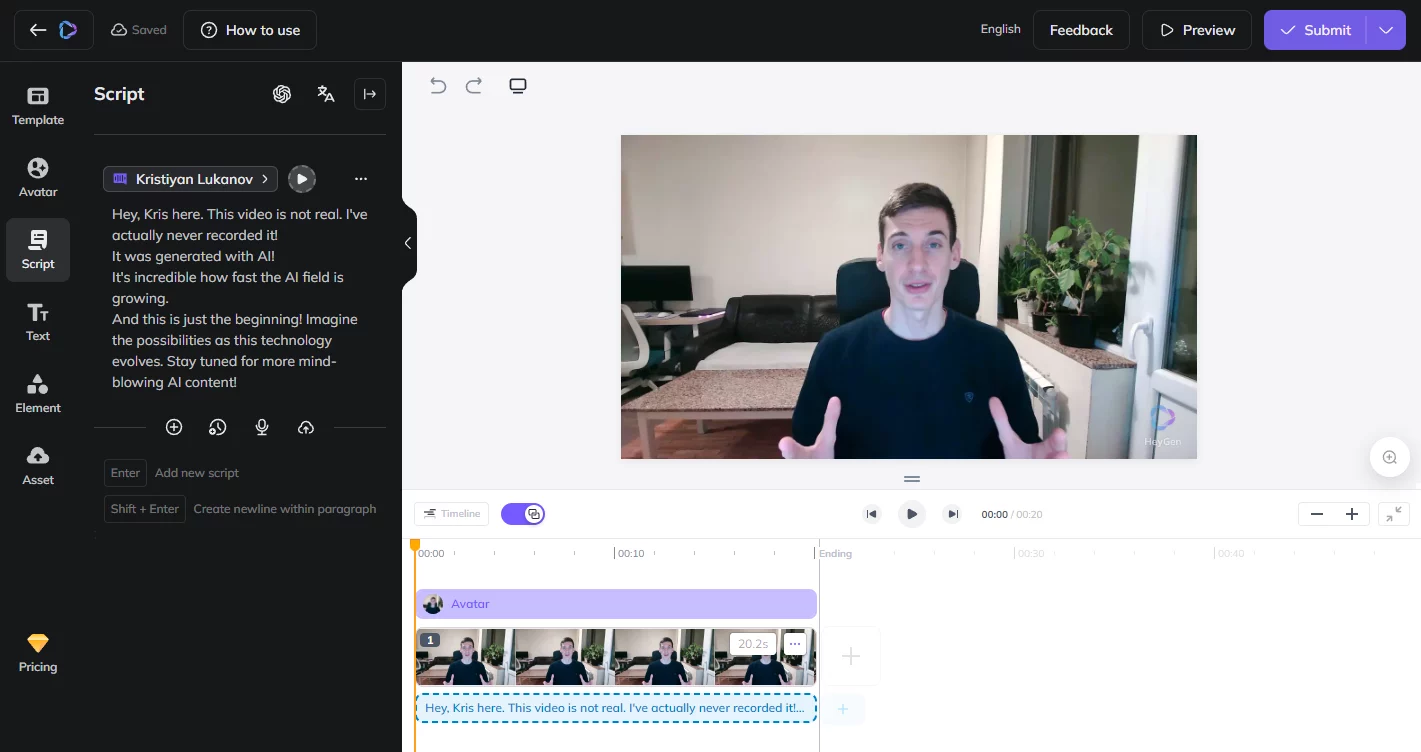
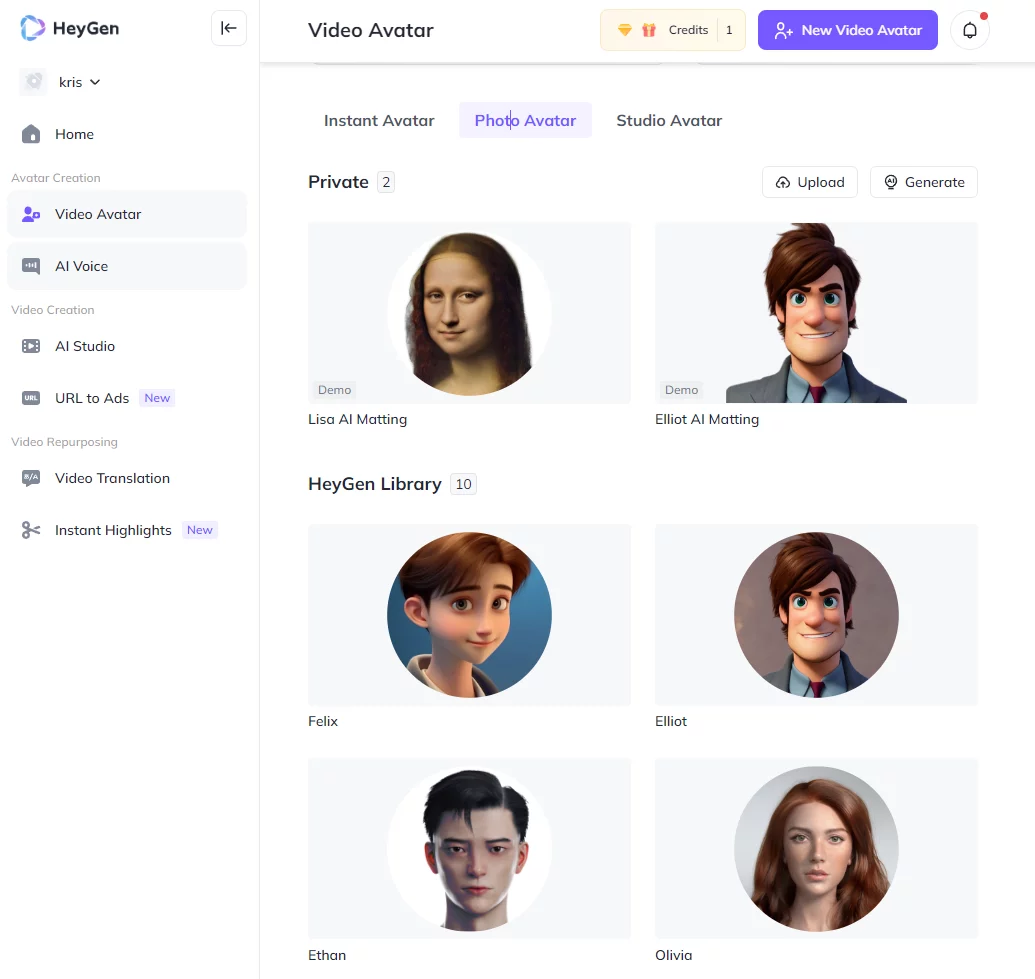
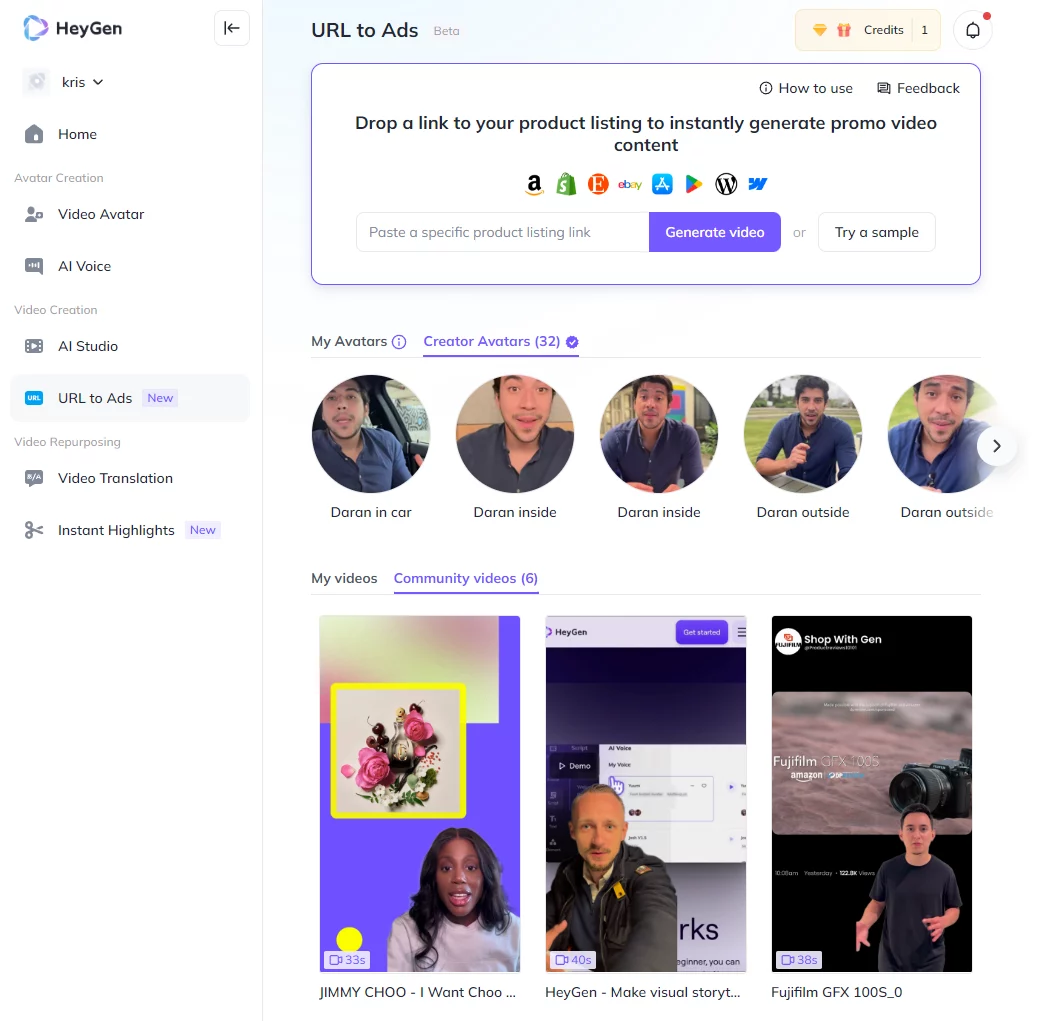
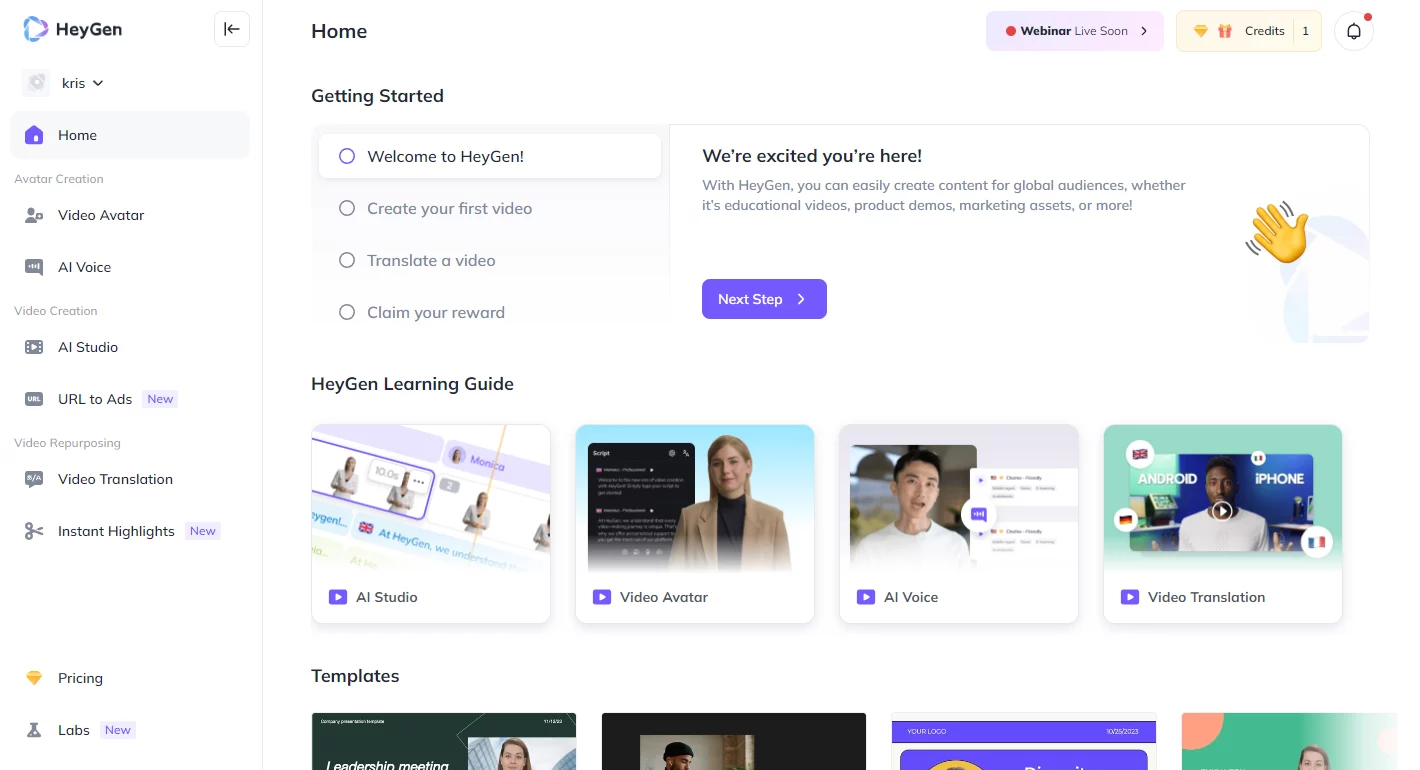
VidNoz
VidNoz is a popular talking avatar generator that is the most affordable out of the ones we compare here. It has a unique feature that allows for creating videos with 2 avatars simultaneously. Great for creating news video content. VidNoz also supports 900 avatars, 470 voices, 1000 templates, and more than 140 languages supported.
It can create a virtual avatar video from a picture of yourself or someone else. The tool supports other AI features, such as face swapper, dancing photo generation, headshot generator, and virtual avatar generator.
On the downside, VidNoz requires a $99 paid yearly to enable the creation of a copy of yourself (custom avatar). If you would like to copy your own voice, it costs an additional $9 per month. So, the custom avatar option adds around $18 per month out of your budget.
Advantages
- Can create videos with 2 avatars
- Ability to create a copy of yourself
- Streaming live avatar
Disadvantages
- Limited customization options for video templates
- Occasional glitches in generated videos
Best for: news, tutorials and explainer video creators
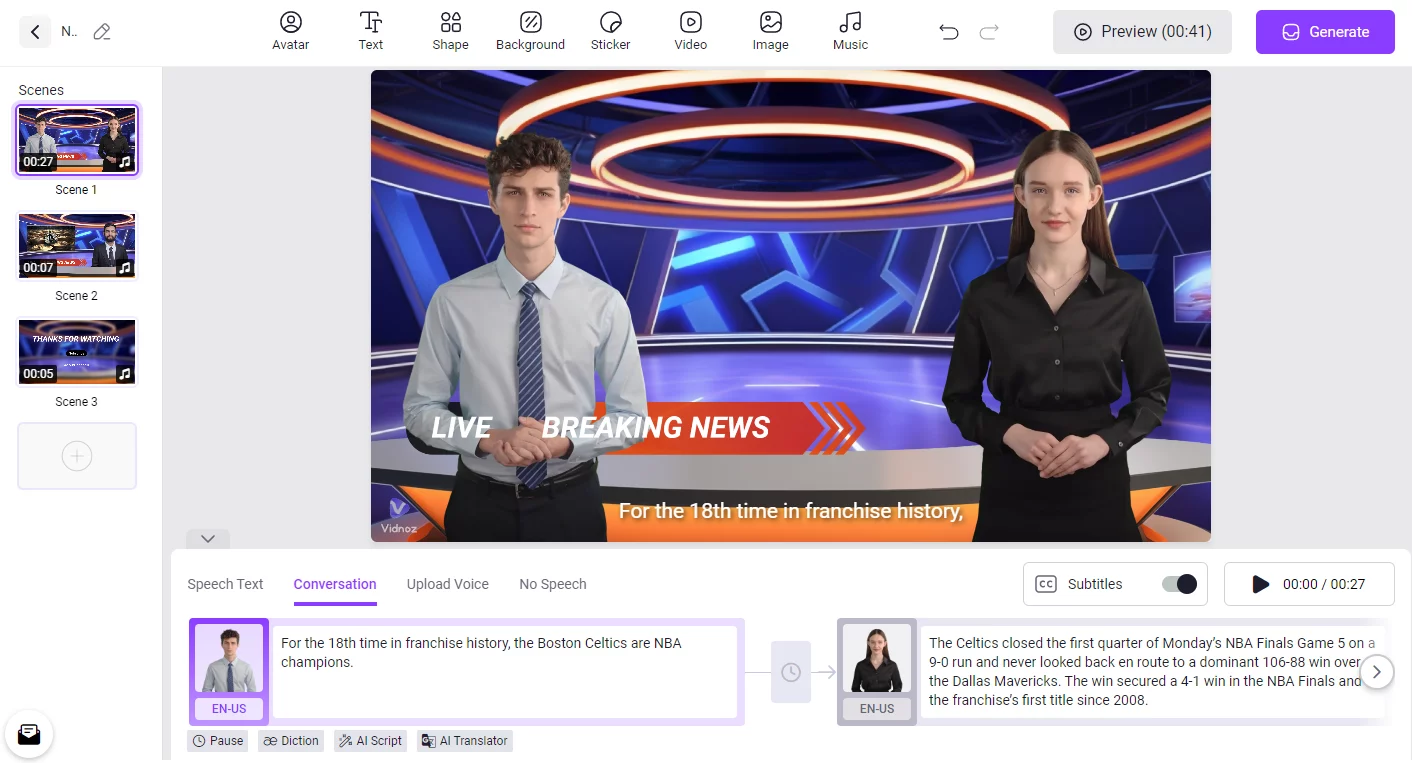


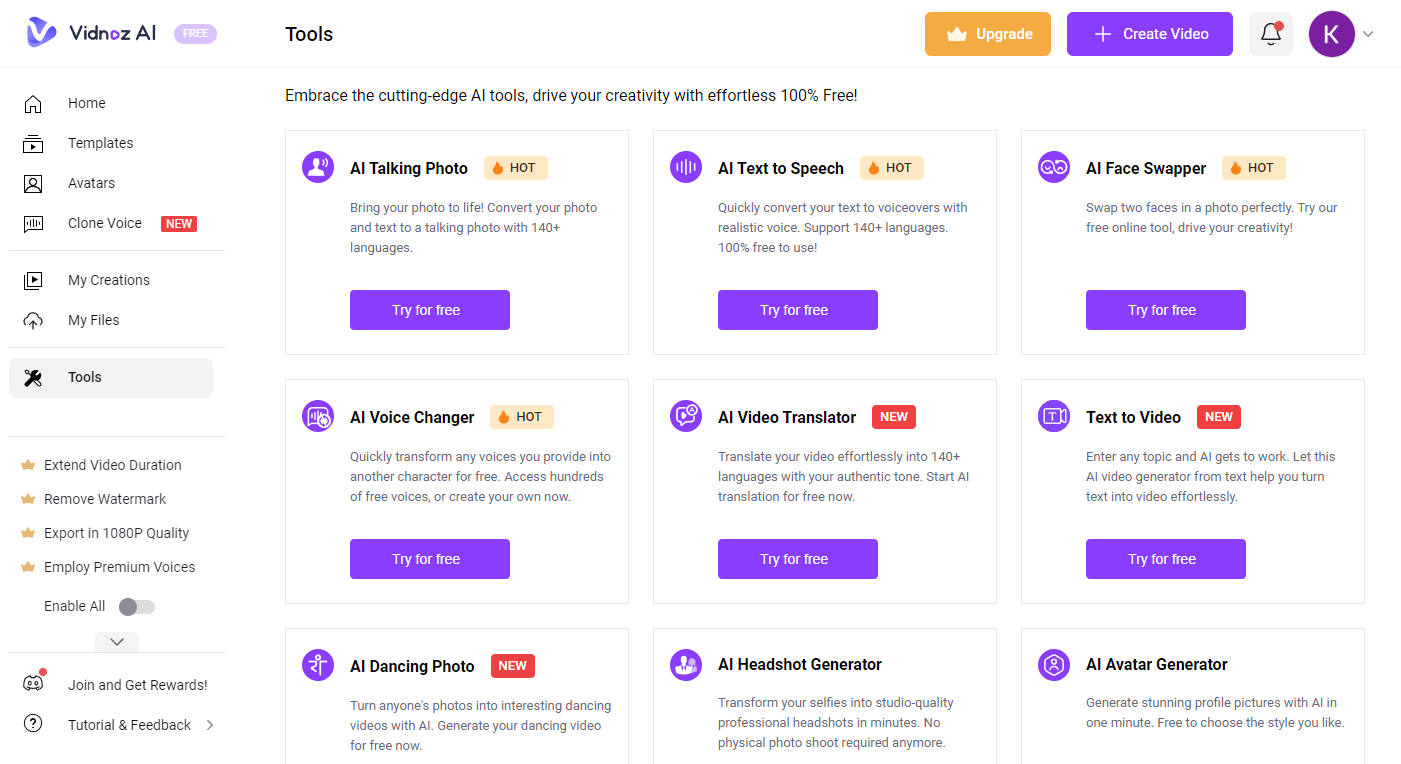
Synthesia
Synthesia is another popular talking avatar video tool. It has an easy-to-use video editor that lets you customize your video using drag and drop with your mouse. Synthesia can also be integrated into business software due to its API availability.
However, Synthesia’s custom avatars cannot copy your voice and you’ll have to use one of the existing ones. It also, cannot generate an avatar from an image and it’s the most expensive one with $3 per minute out of the avatar tools we review here.
Advantages
- Easy to use
- Many languages supported
- Can be integrated into apps through API
Disadvantages
- Expensive $3 per minute
- Not able to clone your voice
- Limited number of avatars and templates
Best for: news, tutorials and explainer video creators
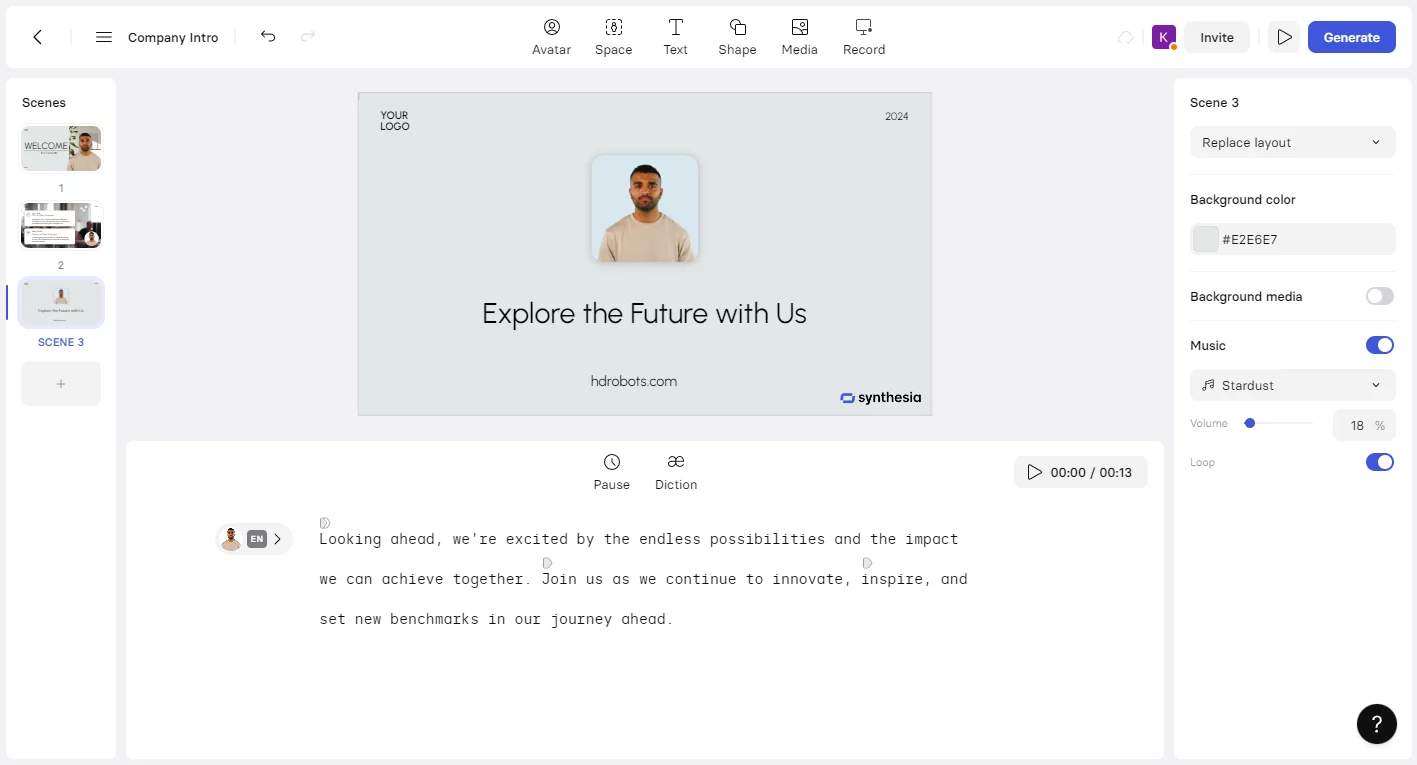
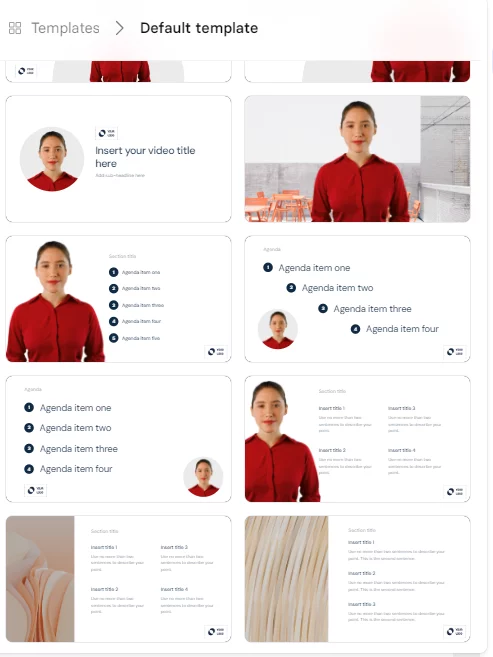
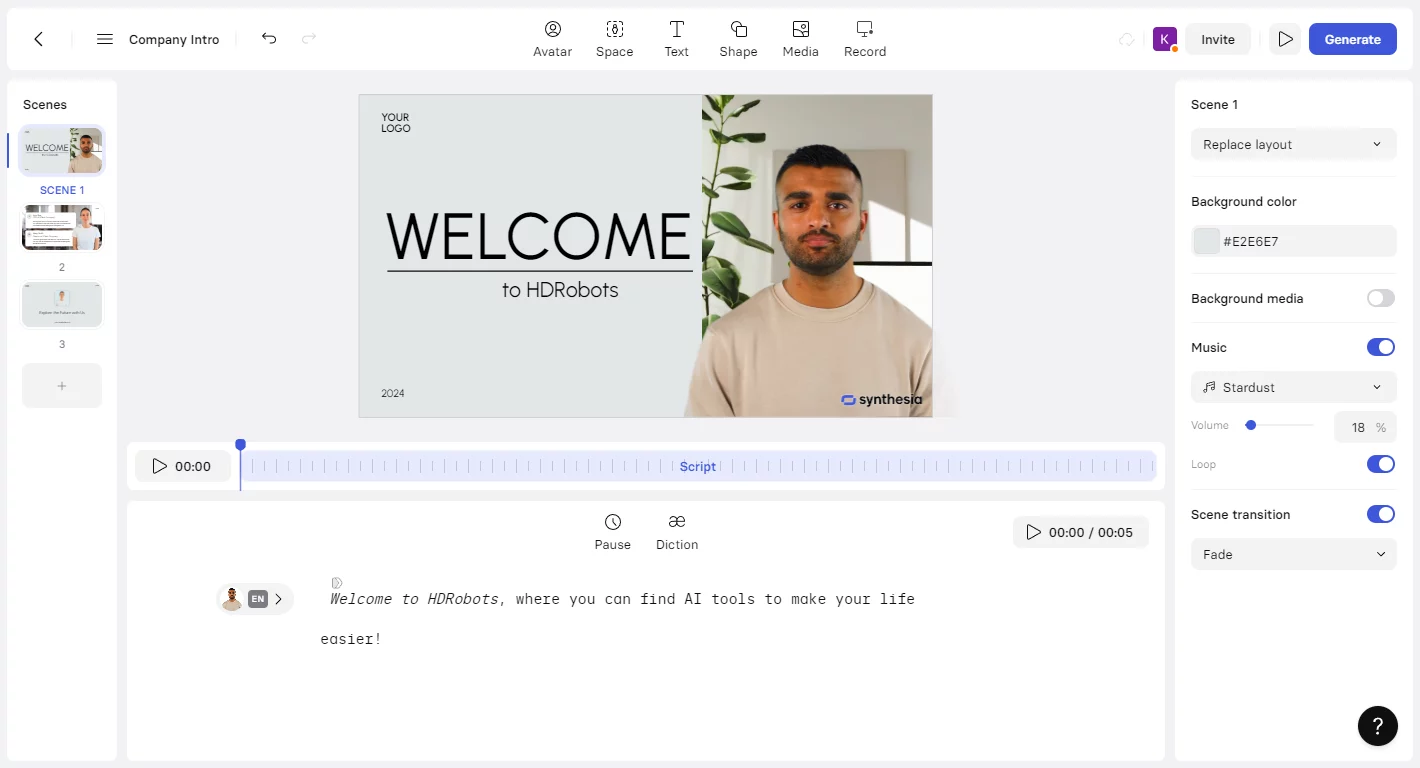
Honorable mention: Veed
We cannot miss mentioning Veed here. It has an awesome video editor. It’s suitable if you prefer more video editing after creating the avatar video. However, it’s more expensive at around $5 per minute for a talking avatar video and has basic AI avatar features.
Bonus: CapCut (free)
The video editor CapCut supports generation of AI talking avatars for free. It has less options than the paid tools, fewer avatars and you cannot create a custom avatar of yourself. However, the realism is good and you can generate an unlimited amount of YouTube and TikTok videos for free. See an example of a created avatar in the video below:
Our recommendation
The best talking avatar tool in the market today is HeyGen and our team recommends it. It has the most realistic avatars, the most features and it’s reasonably priced. However, if you would like to create automated news videos with 2 avatars at the same time, the best tool for that is VidNoz. As a free alternative, You can use CapCut, but it has much fewer avatars, and templates and no ability to create a custom one. It’s up to you to make the final decision.
Generate Animated Explainer Videos
Raw Shorts
Raw Shorts is an online video maker tool specialized in generating animated explainer videos.
This platform allows users to upload a video script, which is then analyzed by AI to identify the main concepts for the storyboard. The tool then automatically finds matching media assets, places them on the timeline, and generates voice narration, creating a video draft within seconds. Raw Shorts is suitable for creating explainers, social posts, and whiteboard videos.
Advantages
- Creates high-quality explainer videos
- Instant video drafts
- Drag and drop customization
Disadvantages
- Limited customization options due to template use
- Slow response times of the customer support
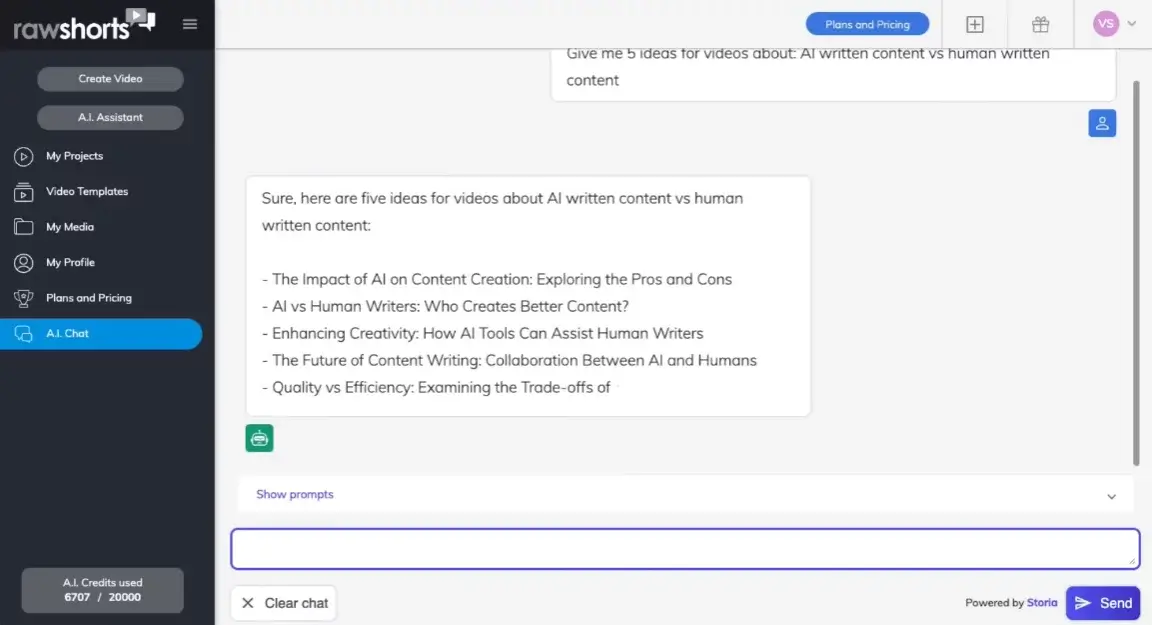
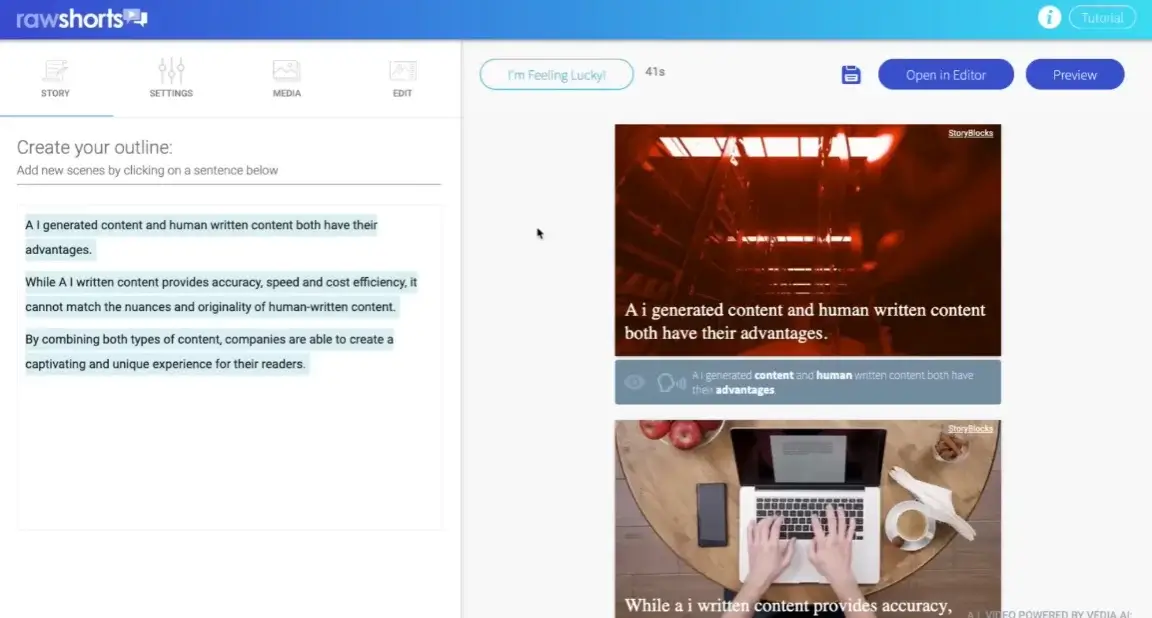
Best for: Beginners in creating animated explainer videos.
The Top AI Video Editors
The above-mentioned tools only give you basic video creation capabilities and if you want to really improve the videos and provide the highest possible quality you would need to use a video editor. They give you a wide range of options to polish your video. For example, improving colors, adding special visual and audio effects, multi-camera editing, and much more.
If you want to create a successful YouTube or TikTok faceless channel it’s advisable if you learn how to use AI video editing tools. In general, they’re slightly harder to use due to the vast amount of features. However, investing time in learning these tools can significantly elevate the quality of your videos and help you stand out on YouTube and TikTok.
We’ve reviewed top video editors that you can use in 2024.

|

|

|
|
|---|---|---|---|
| Ease of use | |||
| Platforms | |||
| Special Effects | |||
| Sharing Options | |||
| Export formats | mp4, mov | mp4, mov, wmv, mts, mkv, avi, mxf, mpeg | mp4, mov, mts, mkv, avi, ts, mpeg |
| Cloud storage | 1GB free | 100GB | 1GB free |
| Collaboration | |||
| Auto captions | |||
| Auto reframe | |||
| Auto reframe | Easy | Hard | Easy |
| Script generation | |||
| Text to video | |||
| Text to speech | |||
| Voice changer | |||
| Translation | |||
| Thumbnail creator | |||
| 360 VR editing | |||
| Long video to shorts | |||
| Performance | Fast | Slow | Slow |
| Pricing | – Free – $8 per month |
– Free trial – $22 per month |
– Free with watermark – $10 per month |
| Go to CapCut | Go to Premiere Pro | Go to Filmora |
CapCut
CapCut is a video editor developed by TikTok and it’s specialized in creating social media videos. It’s easy to use and free which makes it perfect for beginners. The tool has a gigantic amount of free AI features and automations that make editing super easy. It’s the most powerful mobile app video editor that enables you to quickly record, edit, and publish videos. It is suitable for creators of short-form content, particularly for platforms like TikTok and YouTube Shorts, however, it can be used for creating long-form content without a problem.
CapCut has a web platform and downloadable applications for Windows and iOS. It is frequently updated and features trendy social media effects and filters. It also has a built-in long video to short clips auto cutter, music library, sound effects, and sharing to social media platforms.
Overall, CapCut is an ideal start for beginner YouTube and TikTok influencers because it’s easy to use and free.
Advantages
- Free to use without watermarks or usage limitations
- Intuitive, easy-to-use interface
- Great mobile video editor
- Tons of trendy AI features
Disadvantages
- Generated captions sometimes need rearrangement
- Caption inaccuracies
Best for: beginner video editors
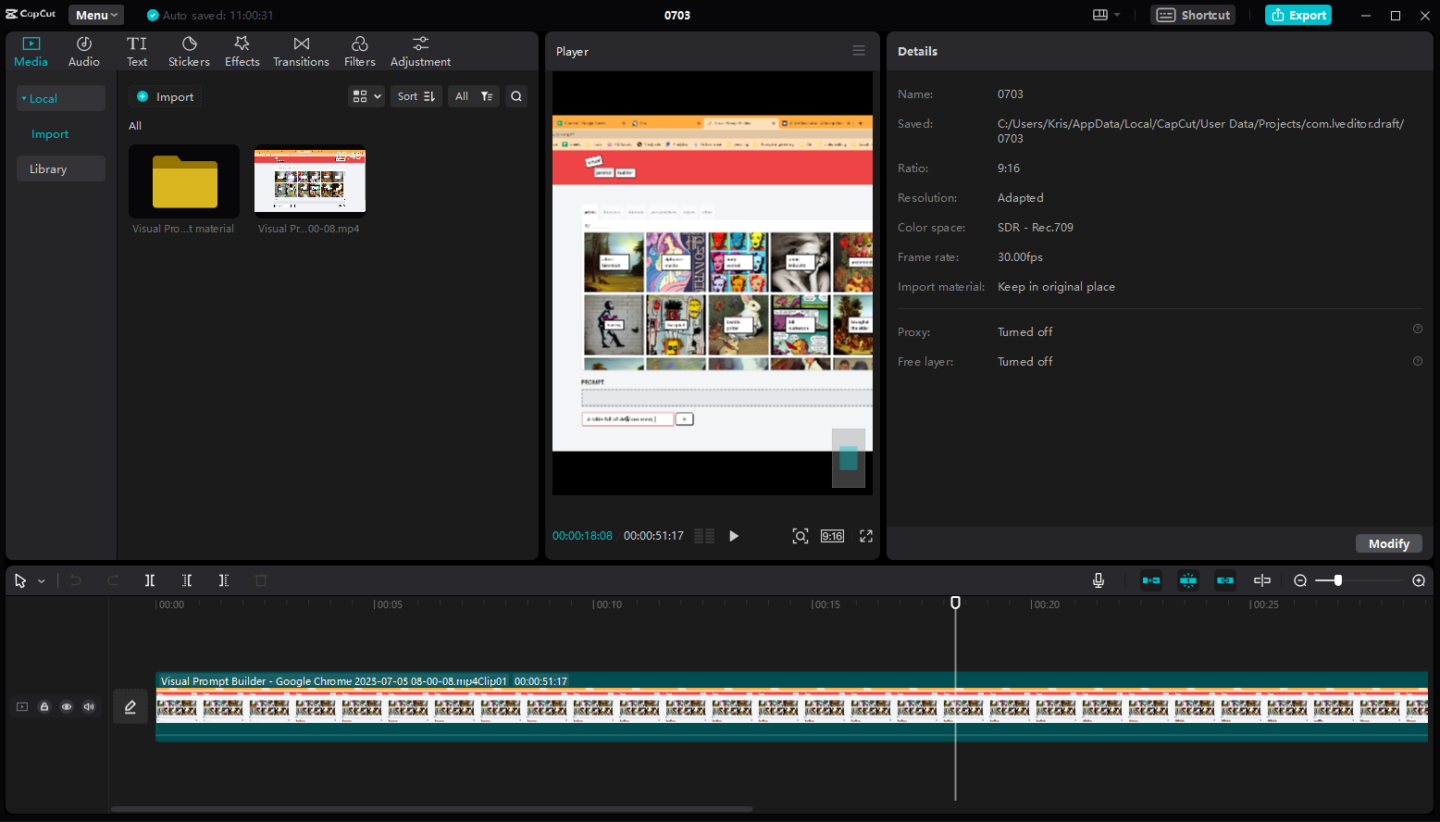
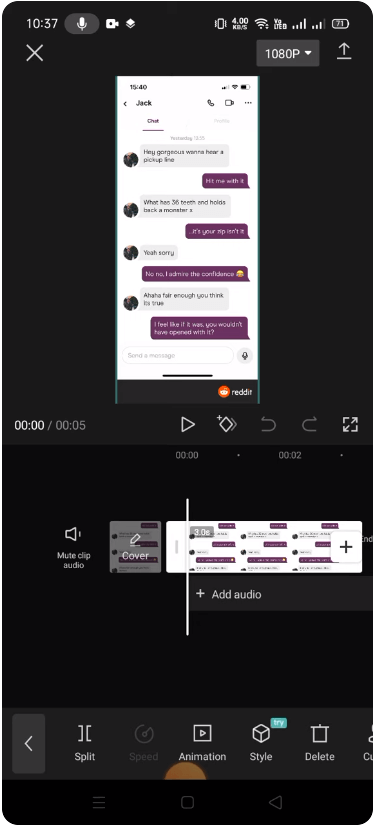
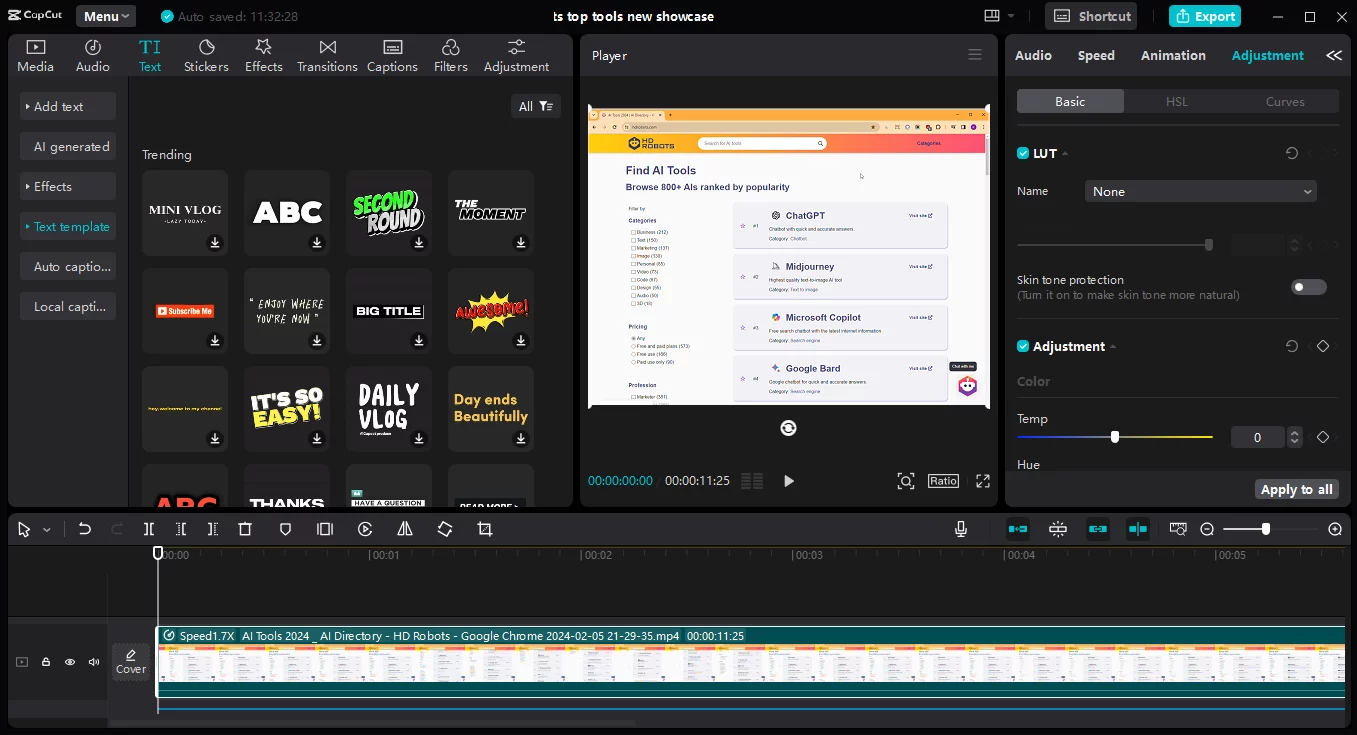
Adobe Premier Pro
Adobe Premiere Pro is a professional-grade video editing software used in the film and television industry, but also widely used by YouTube and TikTok creators. It provides everything you need for high-quality video production. It includes many advanced editing features including multi-camera editing, 360 VR editing, sophisticated color correction, video effects, transitions, audio editing, and more.
Premiere Pro recently added a lot of AI tools, like background removal, auto-captions, automatic speech clarity improvement, and more. The team from Adobe is working on adding other AI features in the near future, so it will get even better.
While powerful, it has a steeper learning curve, takes more time to edit the videos, and is best suited for serious professional YouTubers.
Advantages
- Professional grade video editing
- Integrated AI tools
- Complete set of video editing tools
- Automated object removal and scene cutting
Disadvantages
- Needs time to learn how to use
- The app crashes frequently
- Monthly limit of 500 AI generations
- Sometimes, it needs editing in Adobe After Effects
Best for: professional video editors
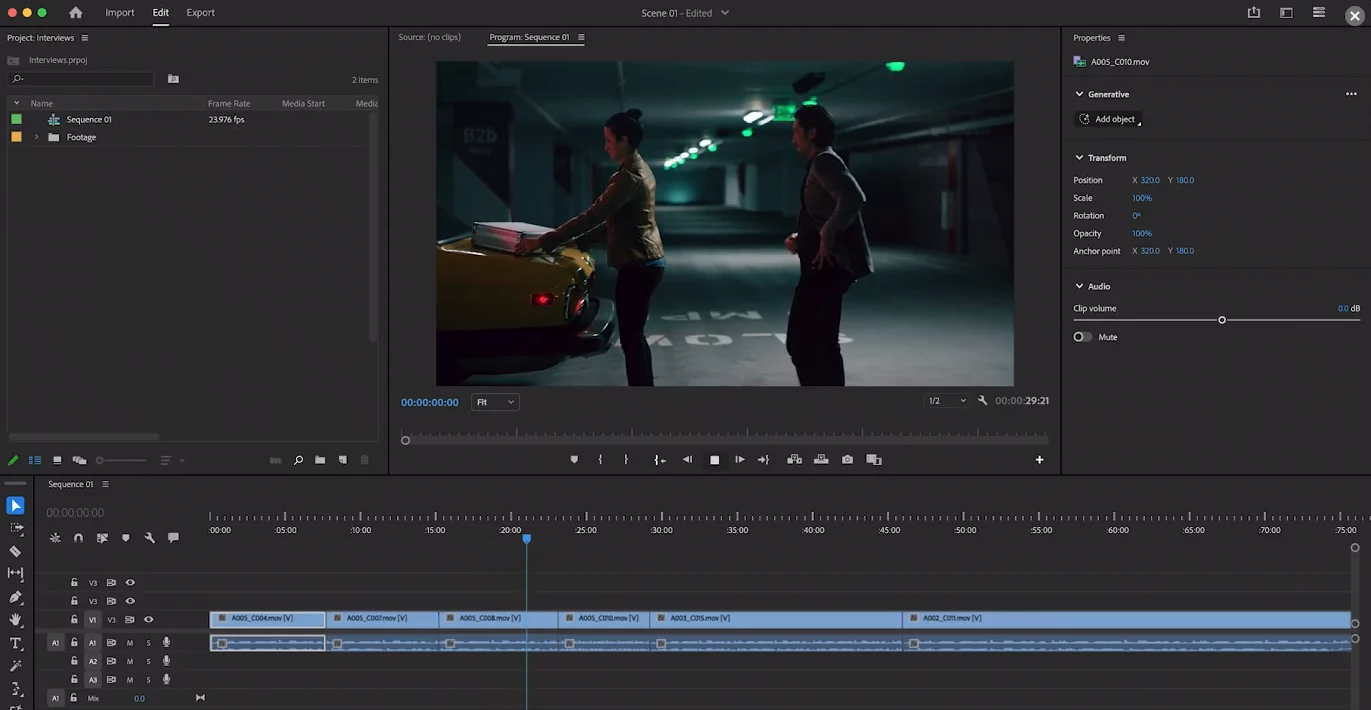
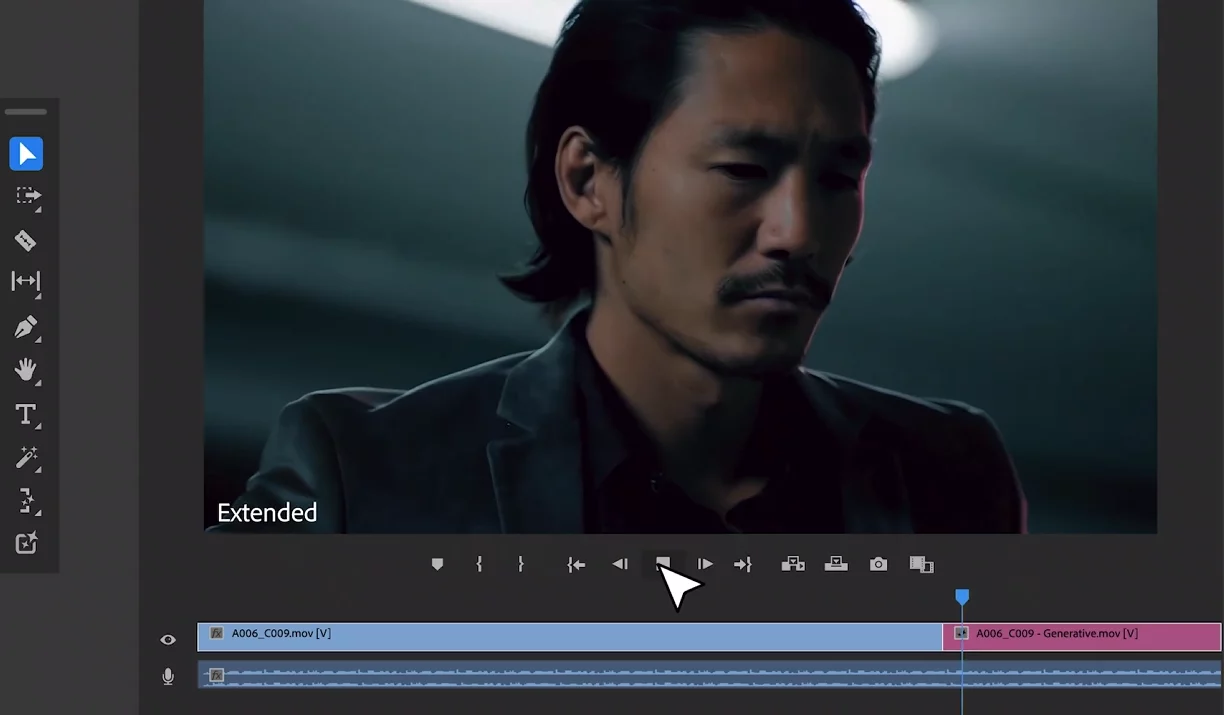
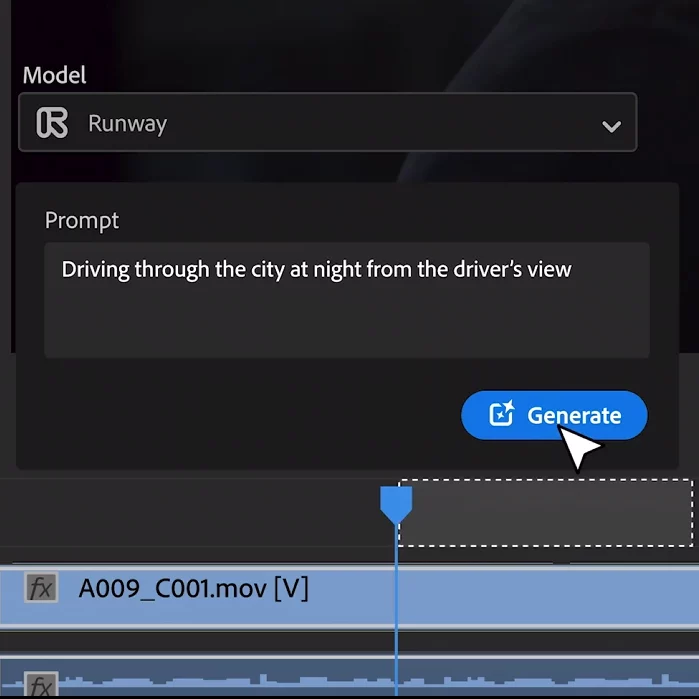
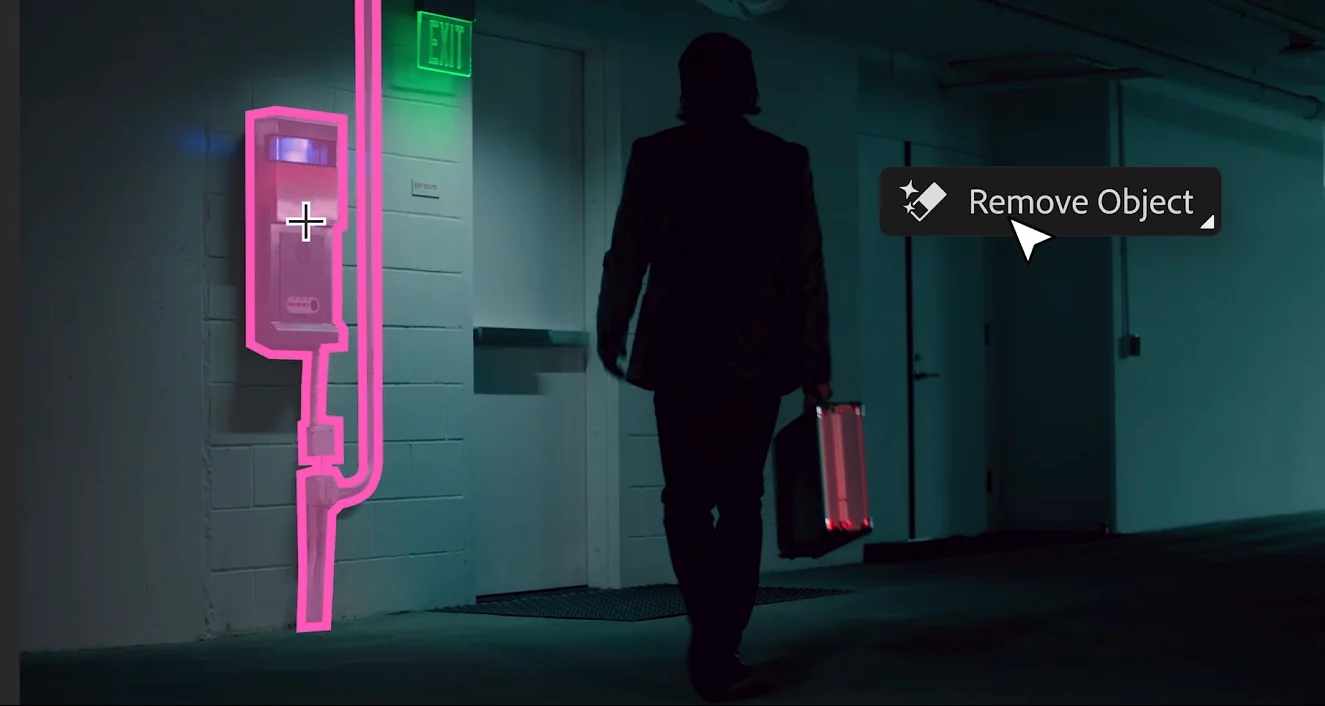
Wondershare Filmora
Wondershare Filmora is a user-friendly video editing software that bridges the gap between basic and professional-grade editors. It’s designed to be accessible to beginners while offering enough features to satisfy more experienced users.
The interface is similar to the one of CapCut and it has comparable features. However, it provides slightly more content creation and AI features, like video thumbnail generation. On the downside, the free version of Filmora adds a watermark to exported videos and CapCut doesn’t.
Filmora comes loaded with a wide range of features such as advanced video effects, transitions, titles, and filters that can add a professional touch to any project. Filmora is popular among YouTubers and TikTokers who need more functionality than basic editors but find professional software overwhelming. However, experienced video editors might lack some advanced editing features for specialized tasks.
Advantages
- Easy to use
- Built-in stock library
- Robust feature set
Disadvantages
- Limited professional use
- The app could become slow
- Some assets are paid
Best for: Intermediate video editors
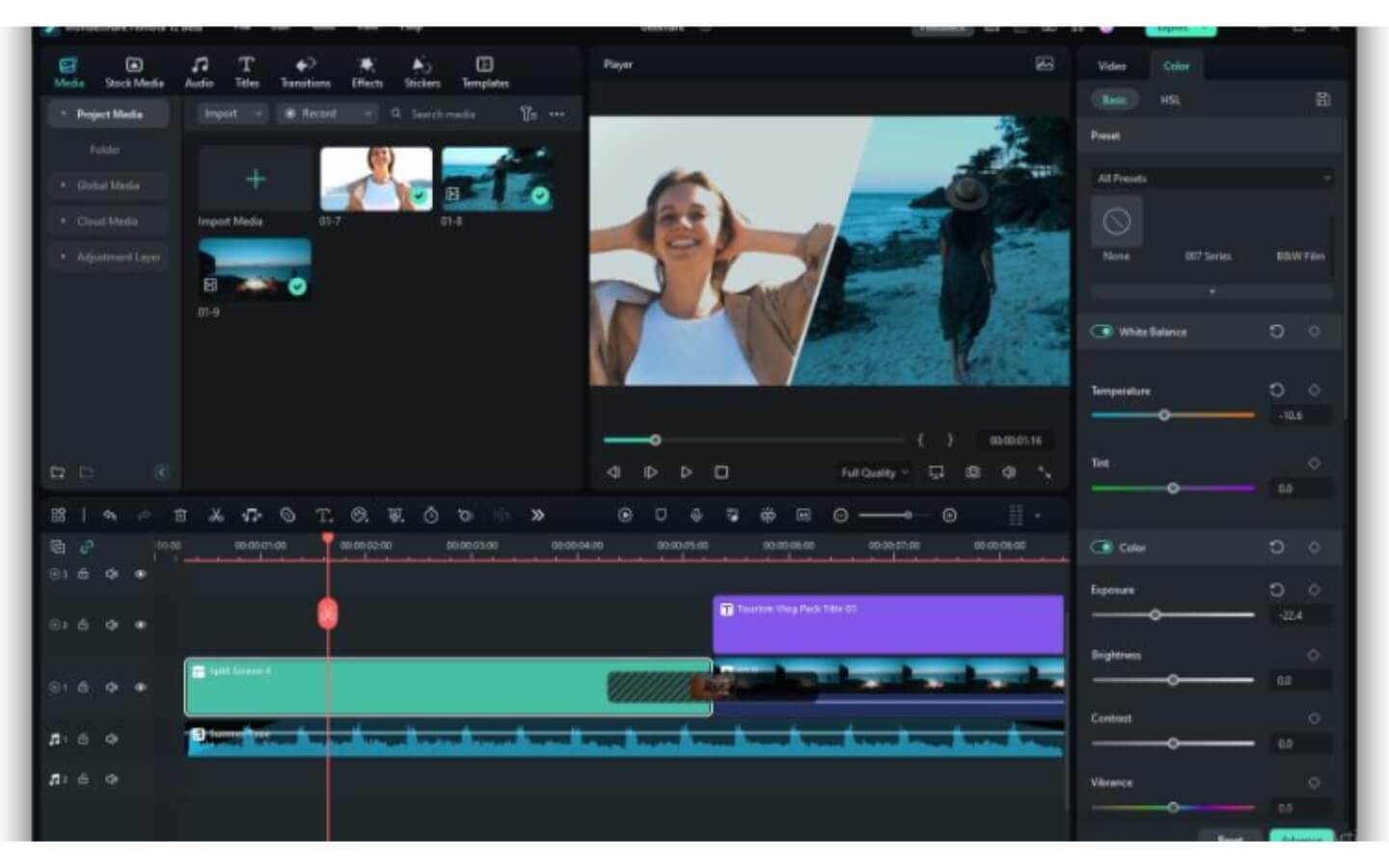
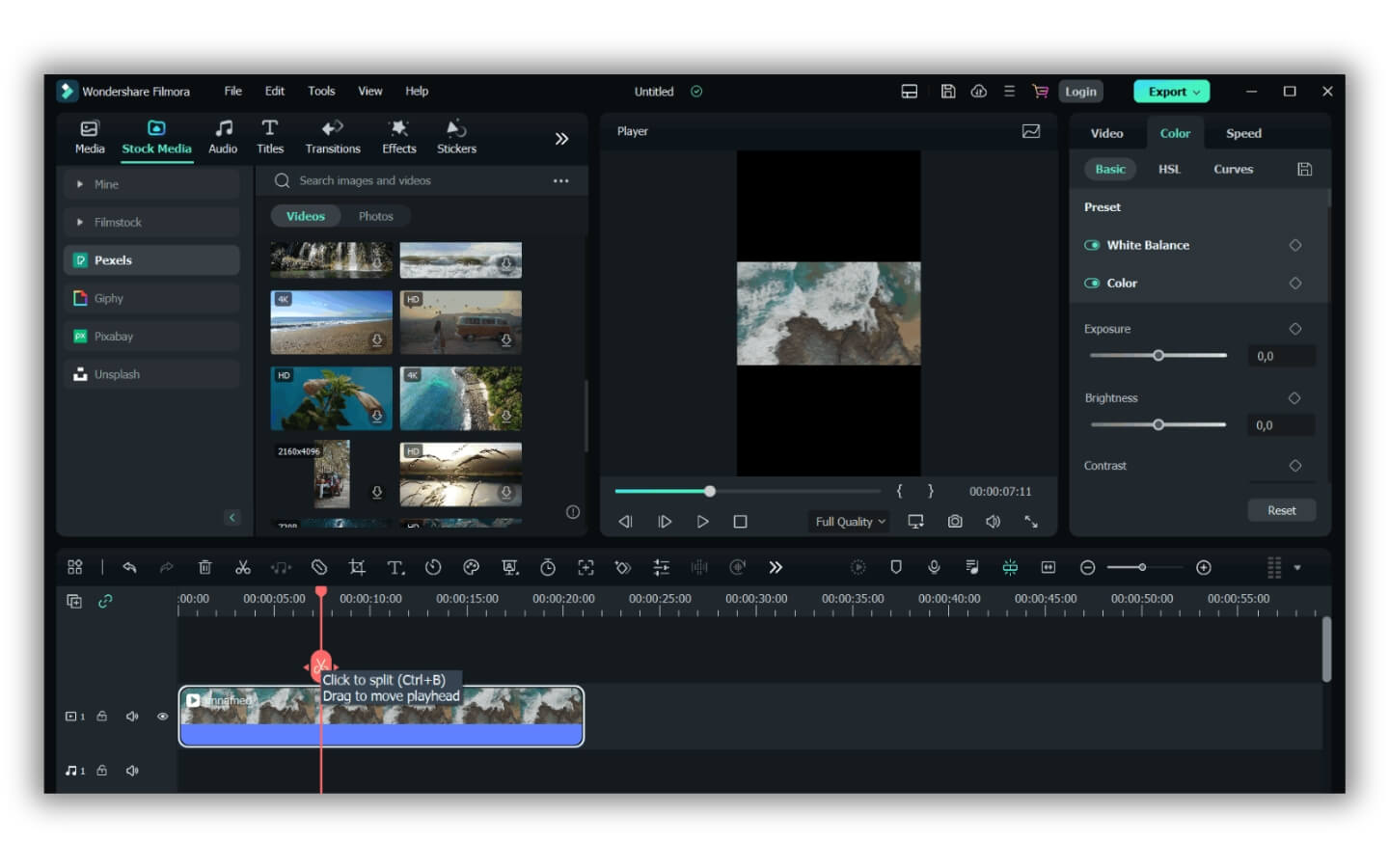
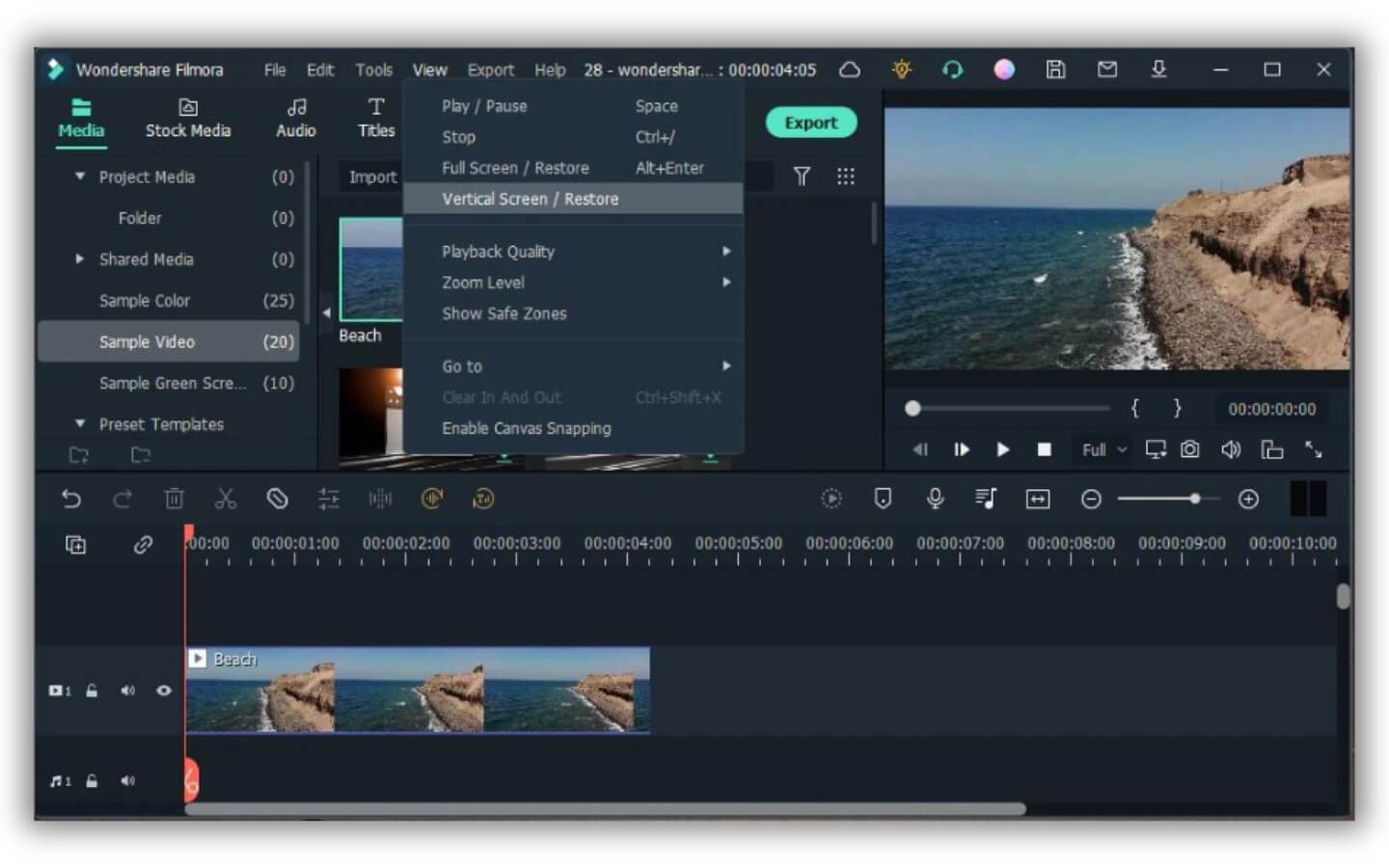
Bonus: Create Custom MEME GIFs to Spice Up Your Videos
Misgif
Misgif is an AI tool that allows you to create personalized and fun GIFs and memes by swapping faces into popular videos, TV shows, and movies. With a simple selfie upload, the AI technology replaces the original face in the chosen media with the uploaded one, creating a unique and entertaining result. It’s great for spicing up your videos and adding some humor.


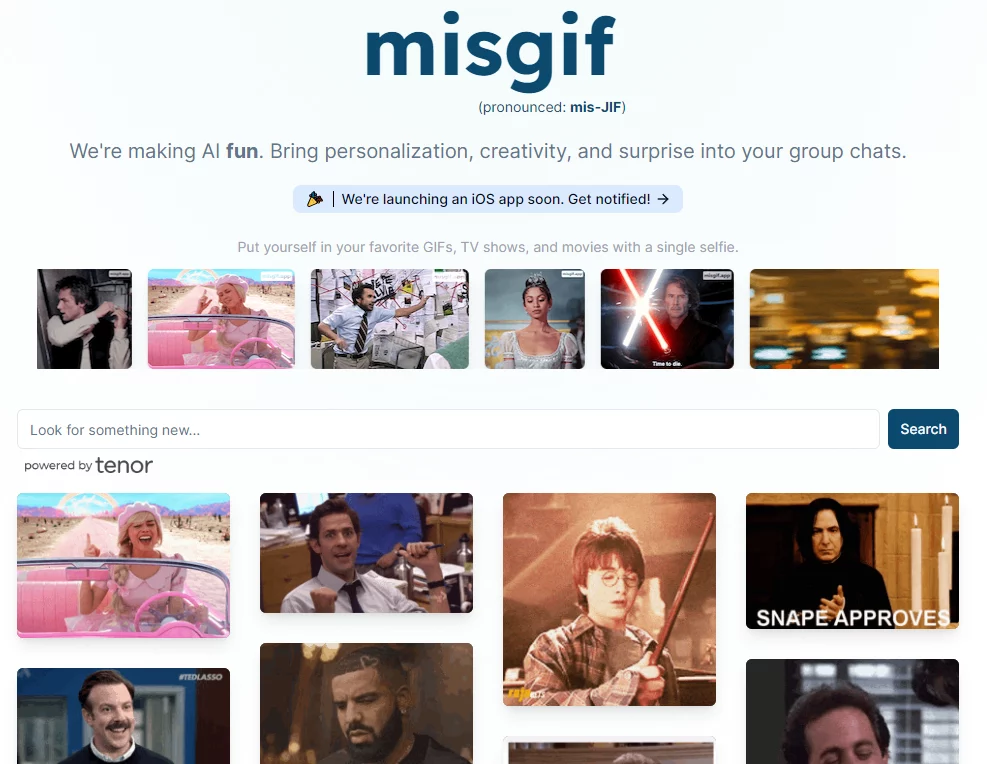
Our suggestion
CapCut is ideal for beginners and mobile users creating short-form content, offering ease of use and trendy features at no cost.
On the other hand, Adobe Premiere Pro is best for video editing professionals and serious creators who need advanced features and don’t mind spending time learning how to use the application. Also, if you would like to edit or create virtual reality (VR) videos, Adobe Premiere Pro is the only video editor here that can edit VR videos.
Finally, Wondershare Filmora strikes a balance, offering more features than basic editors like CapCut, but with greater accessibility than professional tools like Premiere Pro.
Each tool has its strengths and is suited to different types of users and projects. The choice between them will depend on your specific needs, budget, and level of expertise.
Summary
There are many ways to create YouTube videos with AI and make money online. Faceless YouTube automation is one of the latest trends and the reviewed tools have different pros and cons. Their suitability depends on your experience, niche, and budget. Here’s a quick summary after reviewing the best video AI tools:
In our experience, CapCut and Veed are the most versatile video editing and AI video tools to start a faceless YouTube channel. They have the most features that will help you keep things in one place and bring efficiency to your video creation efforts.
More experienced YouTube creators who already have monetized their channels can benefit from using Adobe Premiere Pro along with other AI video tools to keep their subscribers growing. Here’s a condensed list of the best tools to create YouTube videos with AI:
Best video editor: Capcut
Best video editor for beginners: Veed
Best template-based video generator: Invideo
Best article to video generator: Pictory
Best long to short clips cutter: Opus
Best editor for short clips: Submagic
Best talking avatar video generator: HeyGen
Best text to video generator: Runway Gen-3
Best image to video generator: Luma Dream Machine
Best animated explainer video generator: Raw Shorts
The team at HDRobots wish you good luck and lots of followers!




